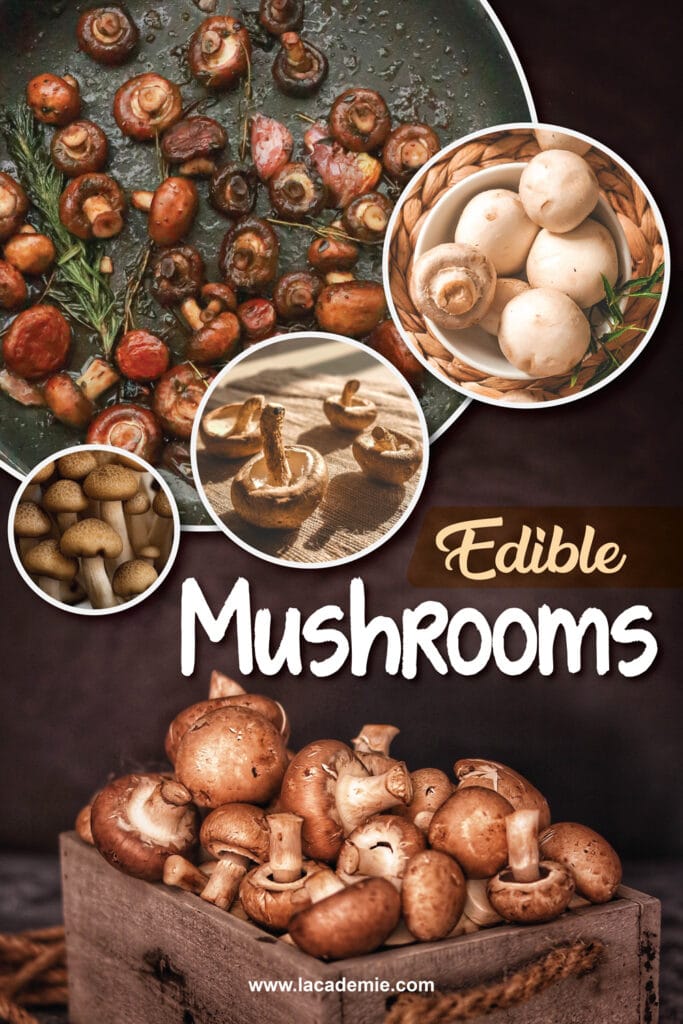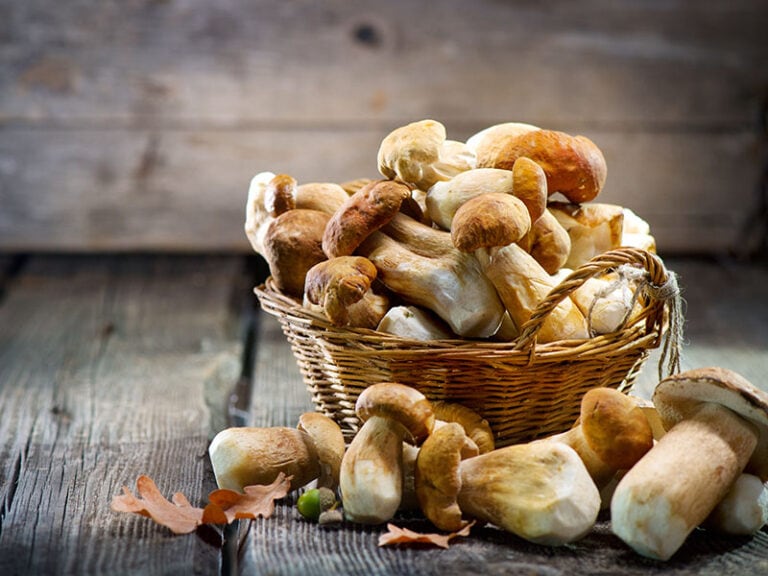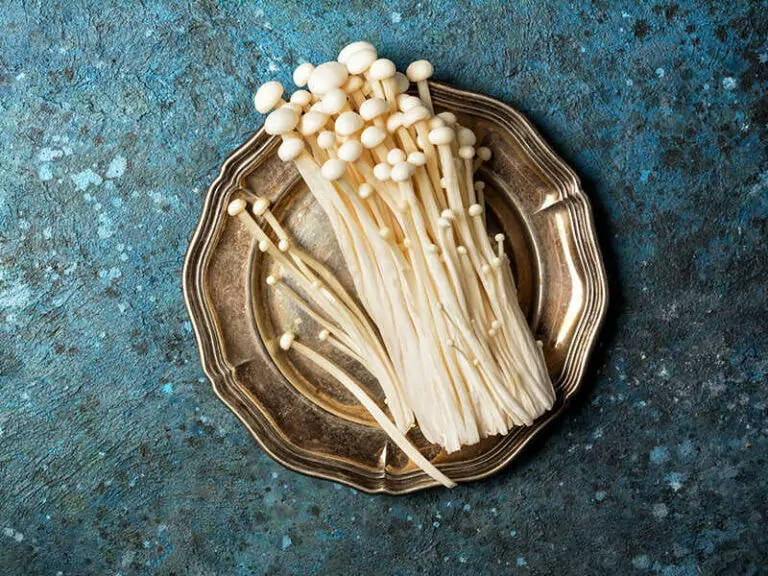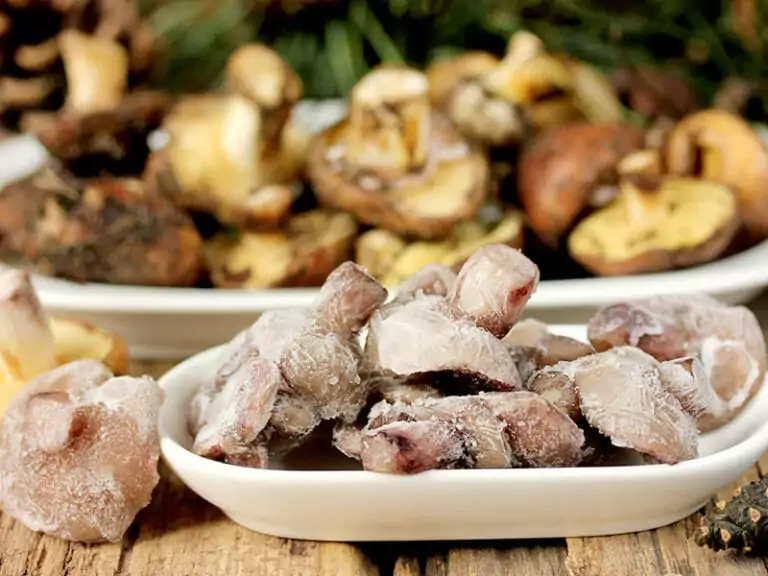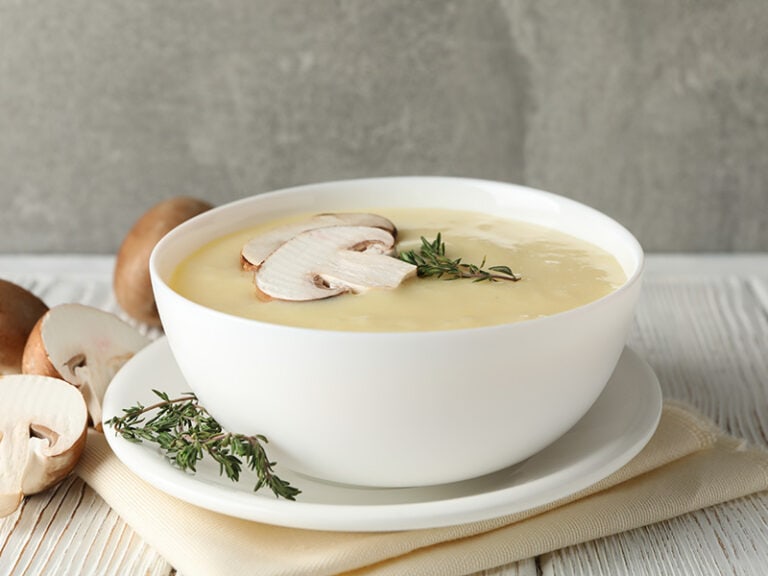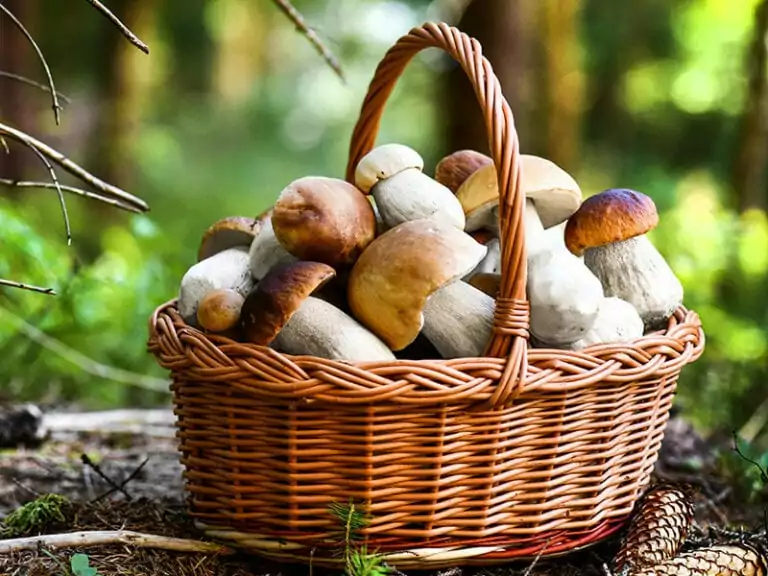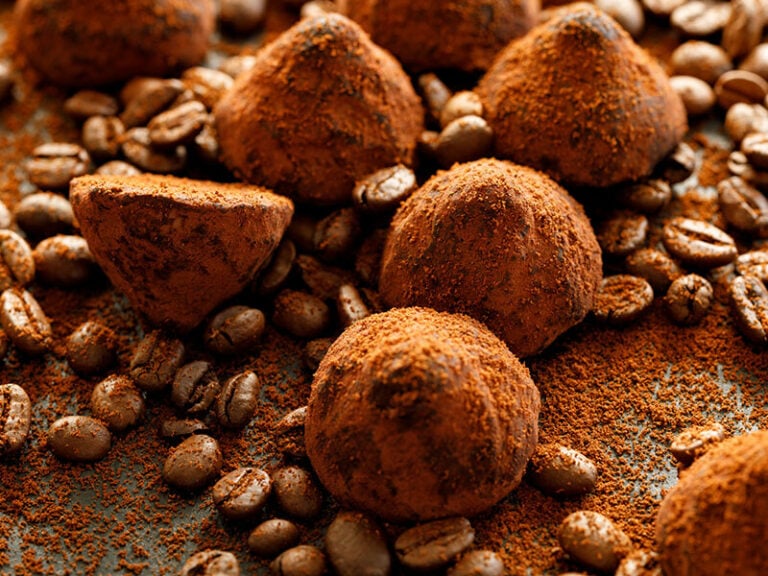But wait, why do you need to know these edible mushrooms with pictures? Well, there are more than 10,000 types of mushrooms in nature, but only 1-2% of them are edible, with distinctive mushroom flavor profiles based on their varieties.
Can you believe how small the number is? That means that the chance of you picking the wrong mushroom is very high and will possibly cause damage to your health. If you have that concern, keep reading because this article will do you a huge favor!
And don’t forget the 3 categories of fungi: Saprotrophic, Mycorrhizal, and Parasitic, because I would classify many delicious mushrooms into these. Just wait and see, you will be thankful you continue reading!
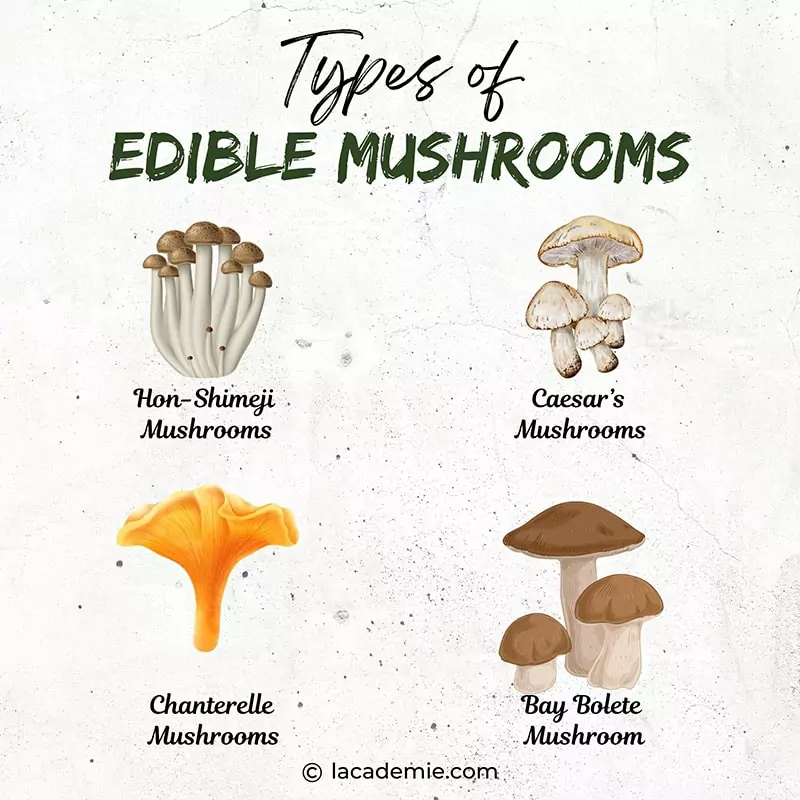
An Introduction To 3 Categories Of Edible Mushrooms
Before we start any further, let’s talk about mushrooms in general.
Some of you must have thought that mushrooms are plants, right? Sadly, the answer is no. Mushrooms are closer to animals in terms of how they gain nutrition, but is mushroom a vegan food? The answer is more complicated.
The signature trait of the plant is photosynthesis for energy, but mushrooms don’t do it like that. I say mushrooms are very close to animals because they have to obtain nutrients from other species to maintain their lives.
But different mushroom variants will have different ways to get their necessary values, and these 3 categories will base on that.
Dividing numerous foods with their names ranging from a to z into smaller categories helps you remember them easier. In this article, I’ll introduce the 3 groups: Mycorrhizae, Parasite, and Saprotroph. So what are you waiting for? Let’s dive right in!
13 Mushrooms From Mycorrhizal Fungi
The way mushrooms in the Mycorrhizae “family” gain their nutrients is quite mutual and friendly compared to other groups of mushrooms. Their strategy is to create an equal relationship with their host plant.
In this symbiotic business, the mushrooms grow by receiving sugar directly from the mother plant. In return, the plants receive a good water source from the mushrooms. Mushrooms are like us; they love to be equal in relationships, isn’t it great?
1. Caesar’s Mushrooms
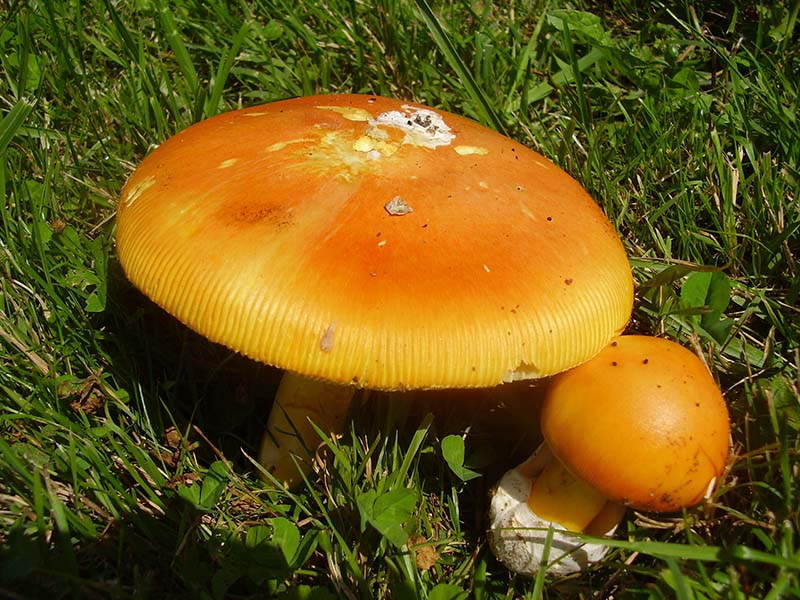
Caesar’s mushrooms have an average size from medium to quite large in the shape of an egg when they are young. But once older, the caps will open and can reach the width of 6-15 centimeters. Due to that, you might see some tears and splits on the mushrooms.
Caesar’s mushrooms are usually found from summer to fall, so you will have all the time in the world to experience them. They have a pretty tender texture with a mild flavor. Some describe them to have a nutty taste of hazelnuts and chestnuts.
Aside from all the tasty flavor, have I mentioned their great nutritional values? Caesar’s mushrooms contain high amounts of copper, zinc, fiber, magnesium. And don’t forget the vitamin B and potassium.
Healthy, tasty, and well-loved by the national consumer, but you might not know a cultural legend about these mushrooms. Agrippina, the wife of Emperor Claudia, poisoned her husband by putting toxins in Caesar’s mushrooms, so her son Nero could be on the throne.
Whether it was true or not, the mushrooms are now loved by the Italians for their tastiness. They are usually eaten raw with salt and lemon juice in the salad, grilled or slightly sauteed, and then served with toasted bread. Caesar’s mushrooms are very versatile for cooking, indeed!
Want special food for an outdoor day? Try sauteing Caesar’s mushrooms!
2. Hon-Shimeji Mushrooms
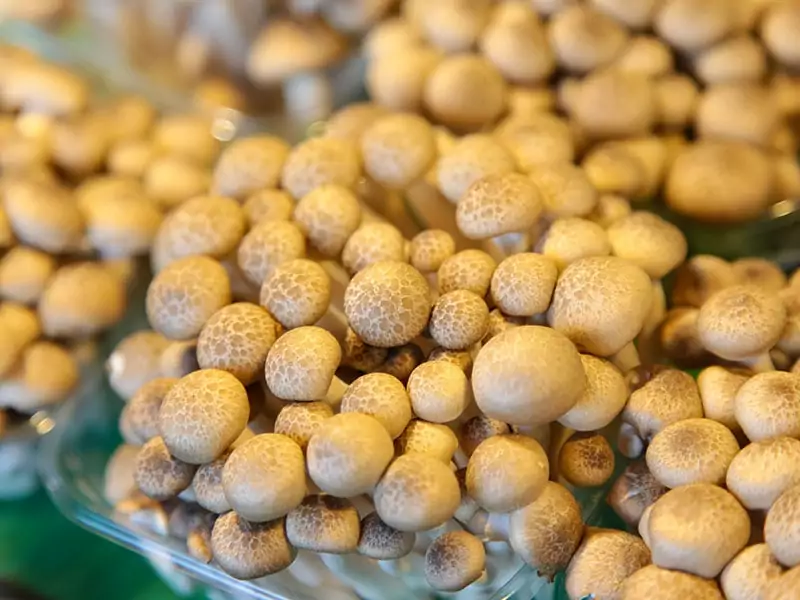
Hon-Shimeji mushrooms are small in individuals, but they grow in a cluster, so they are quite big. They have brown or white round caps attached to the white, slender stem. These mushrooms have a thick, porous base, and no worry, they are edible.
When Hon-Shimejis are used raw, the flavor will be bitter, but when fully cooked, the texture and taste will change completely. They will be chewy with a mild nutty and herbal flavor. The delicacy and versatility of these mushrooms make them the favorite of many chefs.
The Hon-Shimejis suit cooking more than eating raw, so consider putting them into soup, stew, or sauteed dishes. And if you want to try Eastern Asian cuisine, adding them to the noodles, hot pot, or making tempura are all great. They pair very well with all types of meat.
And don’t forget the nutrients. They’re rich in iron, zinc, copper, riboflavin, and many more. Keep in mind that Hon-Shimeji mushrooms have strong cells-wall, so it’s very hard to digest them raw. The nutrients will eventually go to waste because your stomach can’t digest them.
3. Chanterelle Mushrooms
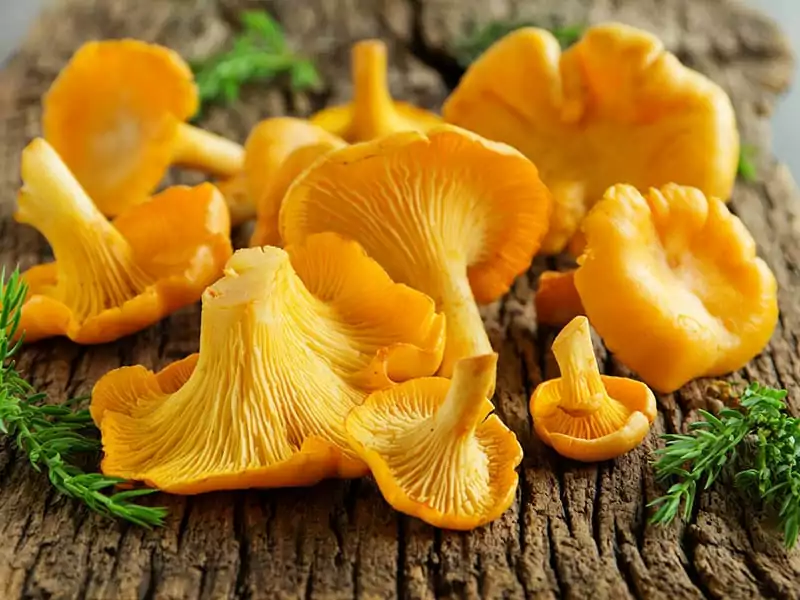
It’s very easy to recognize these mushrooms with their signature orange-yellowish color and the smooth yet uneven mushroom caps. When the Chanterelle mushrooms are cut into pieces, the flesh of the mushrooms is pale white instead of the lovely yellow outside.
This type of mushroom has a chewy, velvety texture with a woodsy flavor, with a hint of peppermint in the end. But the smell of Chanterelle mushrooms contradicts its flavor. They have a sweet fruity aroma, almost like apricot or peach.
Although they can be found all year round, they’re still considered fancy ingredients in restaurants. This is because they can’t be commercially cultivated, so you can only find them in the woods. Because of their natural flavors and smell, they are well-loved by chefs.
But the taste is not all about Chanterelle mushrooms. They’re also very famous for their nutritional values. Chanterelle mushrooms contain a lot of vitamin D2, which helps strengthen your bones, along with a significant amount of protein, iron, amino acids, etc.
Well, then how do chefs bring these mushrooms to the dinner table? Chanterelle mushrooms are versatile, so you can serve them sauteing, boiling, or frying. Or maybe as side dishes with rice, stew, or soup. Don’t hesitate to try a new recipe!
A little tip for you: try putting butter or any kind of fat in your mushrooms while cooking. You’ll be taken aback by how it brings out all the flavor of Chanterelle mushrooms.
Chanterelles’ flavor is the most lovely when combined with onion, garlic, bay leaves, or wine. If you want to combine them with meat, don’t hesitate to try chicken, pork, or quail. But don’t keep them in the fridge too long, or they will lose their natural flavor.
Delicious risotto with Chanterelle mushrooms for a cozy dinner.
4. Bay Bolete Mushroom
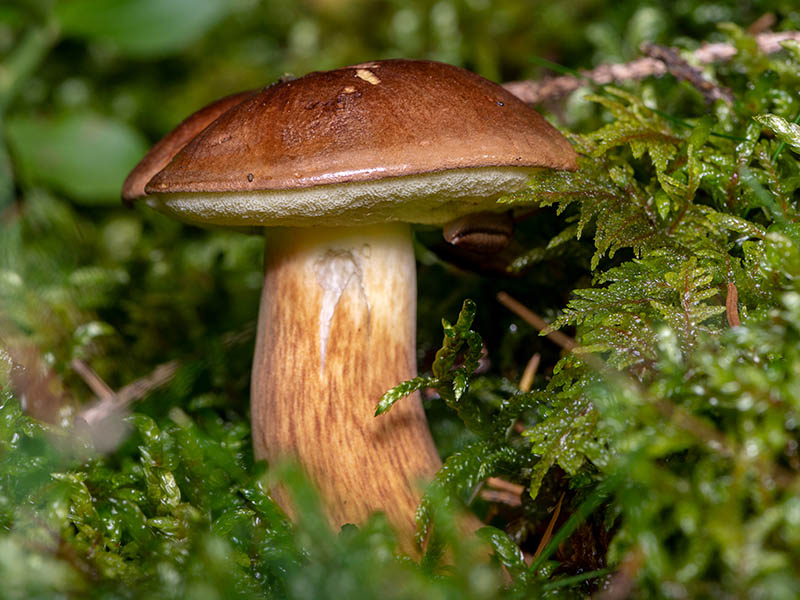
Bay Bolete mushrooms usually grow from August to November, so they would be perfect for your warm food for a winter day. Because they’re not commercially cultivated, you need to find them. The tip is to look for them in dark places with acidic soil under thick conifers.
They have brownish chocolate caps with green pores, while the stems are light brown stripes. One fun fact is that when you cut these mushrooms, they will turn into soft-red colors and look quite similar to meat but with a less firm texture.
Bay Bolete mushrooms have a mild nutty, meaty flavor, while the aroma is more on the fruity side. The texture of these mushrooms is very porous, so they are very soft and absorb lots of water.
These mushrooms are very rich in nutrients, and they will benefit your health more than you can think of. They’re a good source of vitamin D, which helps strengthen your bone, fiber to stimulate your digestive system, and multiple antioxidants, minerals.
But remember that these mushrooms should not be eaten raw because of the toxins. So moral of the stories, cook the Bay Bolete mushrooms. But how? Now worry because I will show you right away!
Bay Bolete will have a different texture for each size, so here is the advice. If you have a small size, try cutting them into half and sautee to let out all the flavors, or you can also marinate them. For medium size, make them into stuff. A add the big size to stew or soup.
But feel free to cook the mushrooms any way you like! Bay Bolete mushrooms go well with a lot of seasoning, especially with bitter herbs like garlic mustard or garden sorrel.
5. Matsutake Mushrooms
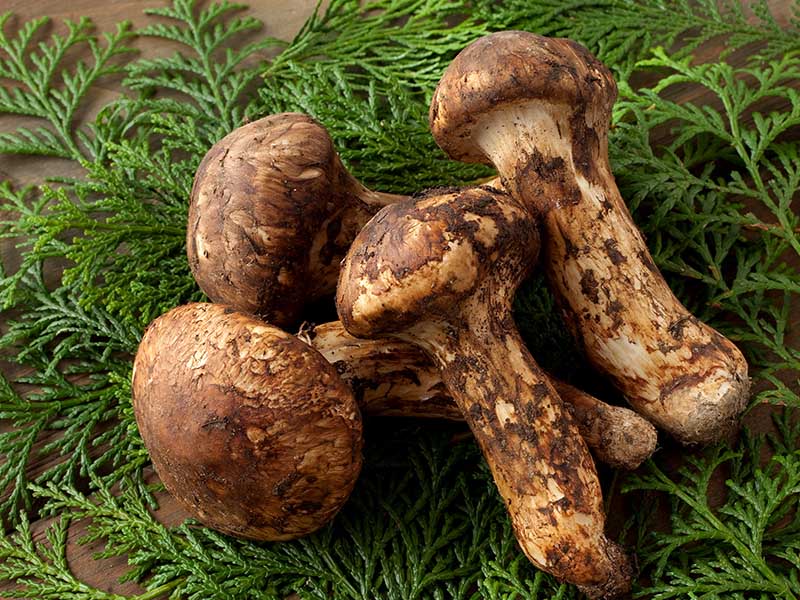
Matsutake – a Japanese mushroom species, is usually found in the size of small to medium. The cap of these mushrooms will open as time passes, and the color also changes from white to brown. Even though they were originally from Japan, they’re now widely consumed internationally.
These mushrooms are available from fall to winter, but because of climate change, the habitat of Matsutake is being threatened seriously. They also can’t be commercially cultivated like normal mushrooms, so you can imagine why the price is eye-popping.
Matsutake is famous for its special cinnamon and pine aroma. What makes these mushrooms famous is their texture and taste after cooking. They turn crunchy and toothsome with a spicy flavor. Many chefs “hunt” for these mushrooms because of that.
The nutritional values of these mushrooms are also incompatible, especially with the source of vitamin D, vitamin B3, potassium, and copper. They’re considered one of the most nutritious mushrooms, so what are you waiting for? Grab some and try now!
Do you wonder how Japanese people see the Matsutake mushrooms in their lives? They are considered symbols of happiness, luckiness, and fertility. That’s why they are given as a gift to newlyweds, not only to show status but also as a blessing.
Matsutake mushrooms are usually served in sukiyaki, a mushroom hotpot in Japan. Or they can be found in kombu dashi, a rice dish, and chawanmushi, a special Japanese egg custard. Matsutakes go well with soy sauce, sesame oil, and most signature Asian ingredients.
But if you want to try them in Western-style, feel free to! They pair well with most vegetables, such as cabbage, carrot, etc; seafood, and mild-flavor seasonings like mirin sauce, sake, or lemon juice. Try sauteing, frying, or using them as side dishes, all you want!
You will never go wrong with grilled Matsutake mushrooms.
6. Charcoal Burner Mushrooms
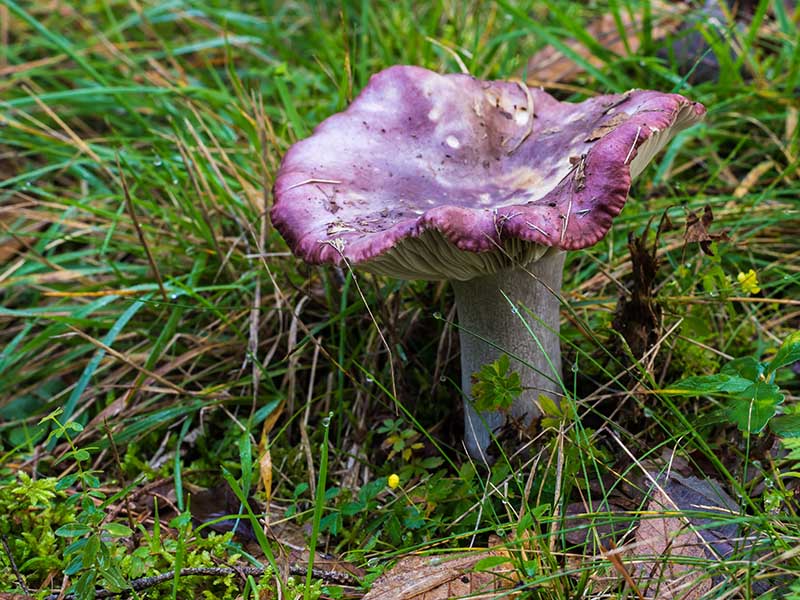
Charcoal Burner mushrooms are very eye-catching with multiple caps’ colors: purple, blue, gray, or even yellow. Because they are widely-distributed mushrooms, you can handpick them almost everywhere without going to the local markets.
The Charcoal Burner mushrooms look similar to the notorious “Death Cap”, so be careful next time while looking for them. But listen, here are some tips to help you avoid unwanted mushrooms.
They have a quite firm, crispy texture with especially greasy, flexible gills. Their spores and stipe are pale white with a crumbly texture. And most importantly, they have no ring. And when you rub them with iron salts, Charcoal Burner mushrooms’ stems will turn green.
These mushrooms are delicious with a unique mushroomy and nutty taste with no usual bitterness that you sometimes find in other mushrooms. But if you are not a mushroom expert, or first time seeing them, don’t use the tasting method.
Charcoal Burner mushrooms are not popular in restaurants, mainly because the income source isn’t sustainable. But I can still teach you delicious ways to cook these mushrooms. Pan-searing or roasting is the best way To keep the original flavors and texture.
But don’t be afraid to add them to the stew, soup, or pasta because their hazelnut taste will level up the dishes. Charcoal Burner mushrooms also pair well with meat, especially fried steak. A must-try for you!
Lastly, Charcoal Burner mushrooms also have multiple nutritional benefits. They provide a good source of vitamin C, D, potassium, magnesium, and many more minerals.
7. Green Cracking Russula
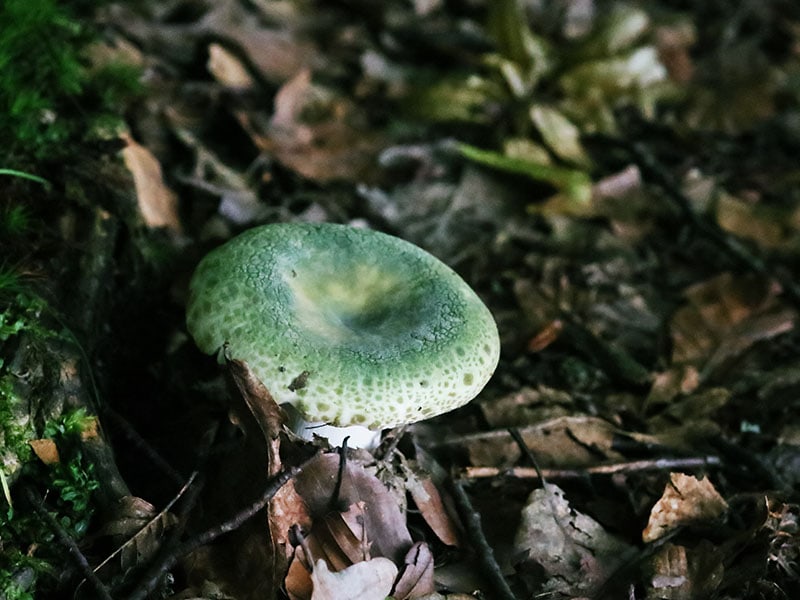
Mushroom expert Atonio Carluccio admitted that these mushrooms were not nice to look at. This is because of the mold-like patterns with green, gray, and yellow colors. Their caps can go up to 15 centimeters with thick, white stems.
The Green Cracking Russula is absolutely edible and tasty with mild nutty, fruity and sweet flavor and nutty aroma when dehydrated. And they have an interesting texture that is both chewy and firm. They’re safe to eat raw, so no worrying about food poisoning!
They also provide a lot of health benefits by delivering multiple vitamins B, C, E, potassium, calcium, and more. These mushrooms are very good at supporting your digestive system, so what are you waiting for? Add them to the menu right away!
Do you think the mushrooms’ green, moldy color will affect your appetizer? Don’t worry, the color will disappear once you cook. Try sauteing, roasting, grilling, or eating raw in a salad, and you’ll be surprised how good it can be. And one secret, they pair well with shallots.
8. Porcini Mushrooms
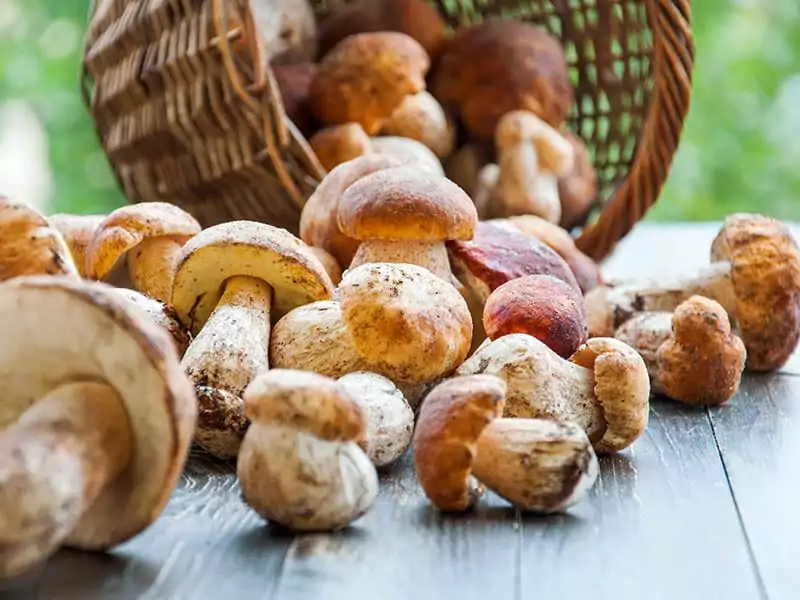
Another member of the Mycorrhizae family I will introduce to you today is Porcini. This type of mushroom is an ideal replacement for cremini mushrooms. They vary in size, especially for the caps, between 7-30 centimeters in diameter. And the stem is dense and thick with a cream color.
The Porcini have a unique red-brown color in the caps, with a slight stickiness on the outside. But when cooked, the texture turns chewy with a bit of creaminess. The flavor of cooked Porcini mushrooms is nutty, earthy with a yeasty aroma, almost sourdough-like.
You can find Porcini mushrooms during the fall and spring, and they cannot be commercially cultivated, so you probably can imagine the price now? But they are still very popular in Italian cuisine, the most famous culinary in the world, so are you curious now?
One of the reasons for their popularity is their precious nutrients in antioxidants, not to mention tons of fiber, iron, vitamin C and A. So Porcini can help reduce inflammation, providing protein, and the latest research suggests they can help kill colon cancer.
Porcini mushrooms are very versatile for many recipes, so you can add them as a topping to pizza, soup, stew. Or you can choose to grill, fry, or sautee them with herbs. But what about eating raw? That works as well. Putting them on your salad or sandwiches is a good choice.
How to cook Porcini mushrooms pasta like a real Italian.
9. Crab Brittlegill Mushroom
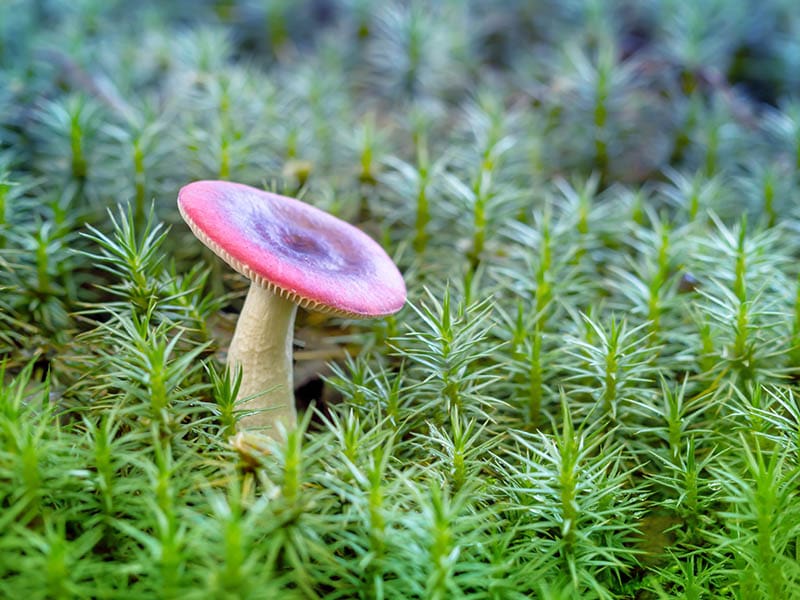
Crab Brittlegill mushrooms are not commercially cultivated, so you will have to search for them yourself. But don’t worry, they usually grow around conifers, so just check for them around pine trees during August, September, and October.
These mushrooms are very easy to find because they have the signature dark red color on the cap, which usually is a warning sign in nature. They grow in a group with a height that can go up to 10 centimeters. Plus, their caps’ texture is very slippery.
Crab Brittlegill mushrooms are very nutritional, with multiple vitamins and minerals. But aside from that, what makes these mushrooms special is their ability to anti-tumor and anti-parasite.
This type of mushroom is very delicious, with a signature shellfish-like taste and crispy texture. Yet, the aroma of Crab Brittlegill mushrooms is the highlight because when you crush them and warm up with hand temperature, you’ll notice the fish crate smell.
Because of these traits, you should use them as topping for the seafood dishes, so the flavors can enhance each other better. Preferably add them to light-flavor dishes so that the original taste can shine. You can also put them in sauce, soup, or stew to bring more flavors.
10. Truffle Mushrooms
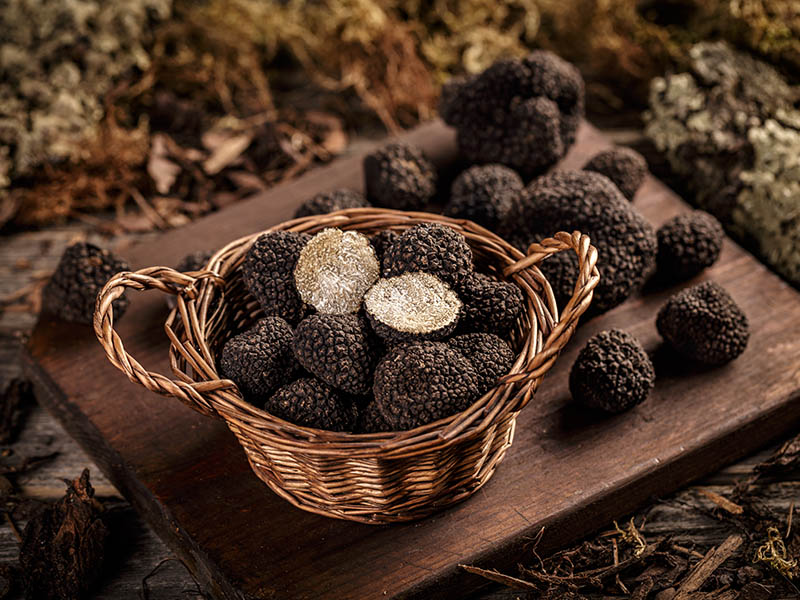
Truffle mushrooms are no longer a stranger to many people. Even if you haven’t had a chance to try them, you still know a thing or two about this mushroom. But here, I’ll provide a closer look at truffles and other information about them.
The size of these mushrooms varies from 2 -10 centimeters in diameter, and they have dark brown lopsided and clumpy skin. Some even say the skin of the truffle is similar to alligator skin.
These truffles’ flavor is mild and elegant, almost similar to Cremini mushroom, but have a strong mix of garlic, chocolate, and hazelnut. The high-end chefs love them for their amazing taste. And here’s an Italian traditional way to preserve these mushrooms.
Start by cleaning the mushrooms with a dry brush, don’t soak them in the water at all. After that, carefully shave the skin and infuse them into olive oil with garlic to increase the flavor. You can store them in the freezer for 3-6 months, but some flavors would be gone.
Because the flavor of these mushrooms is strong already, try to minimize the cooking method. Just need to slice them thinly and use them as topping for pasta, pizza, salad, or soup. Truffles are perfectly made for all meat: steak, poultry, or seafood are all welcomed.
Good taste is not the only thing. Truffles bring but also the nutrients. They are rich in vitamin C to boost the immune system and calcium to strengthen your bones. Truffles are also a good source of antioxidants, fiber, and iron. Do you understand why they’re pricey now?
Level up your creamy pasta with Truffle mushrooms!
11. False Morel Mushrooms
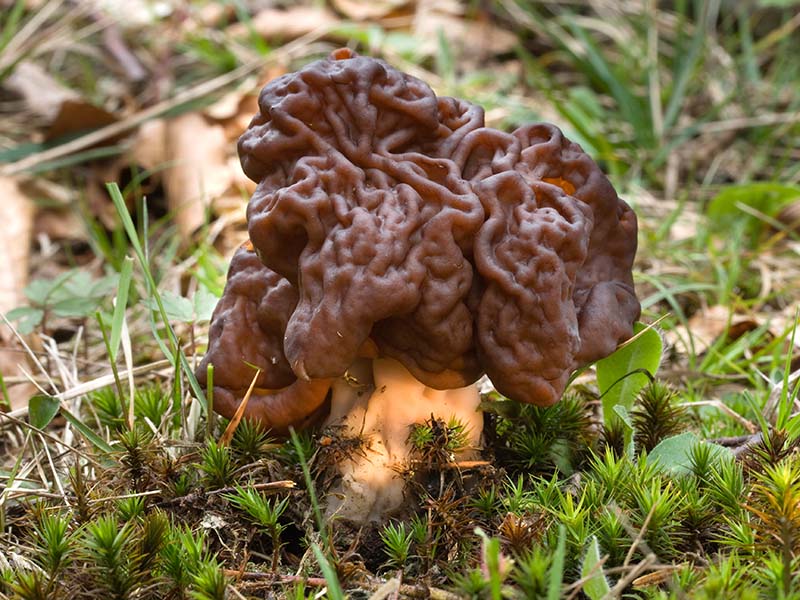
Well, it’s a bit misleading to call them “False Morel Mushrooms” because they are a distant cousin with a similar look: dark brown color, brainy patterns with egg-shape caps. About the taste, they are mildly sweeter. Lastly, they belong to the Mycorrhizae family.
You can find them in sandy soil that is rich in woody debris, so try to look for them around the pine tree. But before we go any further, please know that these mushrooms are partly poisonous. And they are responsible for up to 23% of mushrooms intoxication in a year.
The toxic problem will happen when you consume large quantities, for many days or undercooked. That’s right, don’t eat them raw or do the taste test. You wouldn’t want any gassing, loss of muscle, or even death.
But if you still want to try them, let’s learn how to cook them properly first. To make sure, just cut them into small pieces and boil them for 15 minutes, and then you can add them to other dishes, like saute, stew or soup. Again, please cook them thoroughly.
And even though they can be dangerous, they are actually very healthy with plenty of vitamin D, B2, B3, potassium, iron, and many more. But still, be careful when you want to try these mushrooms.
12. Gypsy Mushrooms
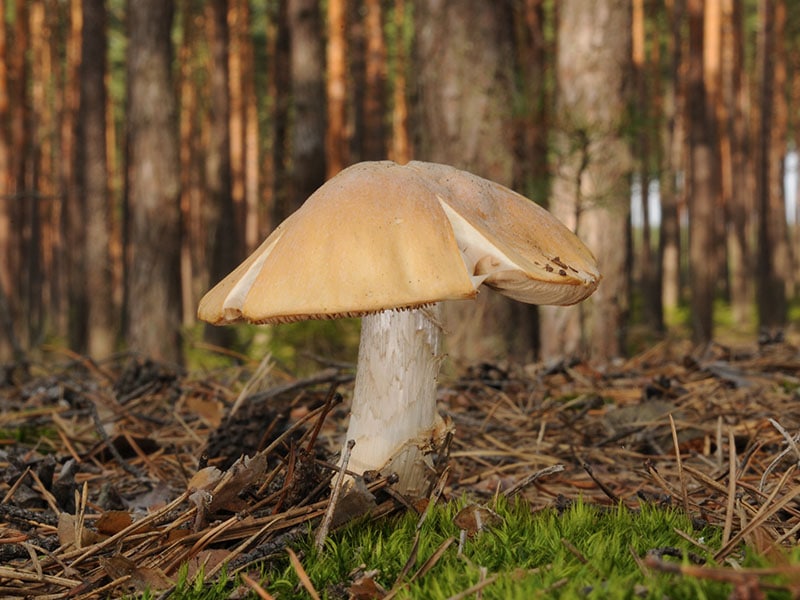
The Gypsy mushrooms used to be listed as “vulnerable” in Germany, the UK and “endangered” in the Netherlands. But now they’re quite common across Europe and even more commonly found in North America.
They have egg-shaped caps but slowly open to umbrella-shaped as they mature. The color is a signature brown-yellowish color with a white, thick stem. The taste of Gypsy mushrooms is mild, with a hint of woodsy and umami flavors.
These mushrooms are nutritious with multiple vitamins as well as minerals. But most importantly, research shows they are efficient in anti-virus. They are reported to help suppress herpes simplex I and II, influenza-A, and other viruses.
When eating raw, Gypsy mushrooms can be a bit bitter. But once cooked, they will give out a nutty flavor. So you can roast, grill, or sear them before eating. That way, the mushrooms will keep their natural crispy, chewy texture.
You can dry them for later use and add them to your soup, stew, or pasta. The nutty flavor will be stronger when dehydrated, and you can keep them longer!
13. Hedgehog Mushroom
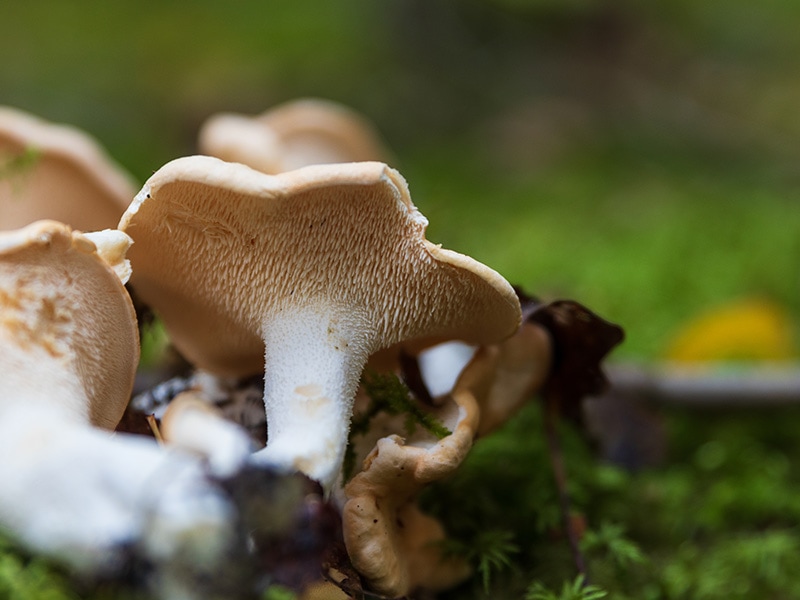
Hedgehog mushrooms have flattened caps with off-centered stems. Their colors vary from yellow, orange, and white; and again, have no relation to a hedgehog. But what matters is they taste good, right?
Hedgehog mushrooms will charm you with the special earthy, nutty, and smoky flavor with a hint of pepper. They also have a fruity aroma with a chewy texture. And that’s the reason why they suit a lot of cooking applications.
Hedgehog mushrooms fit meat a lot, especially beef, poultry, veal, etc. So you should totally try to sautee these mushrooms and serve them along with the meat. But that’s not the only way: Baking, cooking to stuffed, adding to soup,… are all good choices.
And don’t forget some of their favorite seasonings to increase the flavors, such as herbs, garlic, green onions, chives. One little fun fact, you can actually use Hedgehog mushrooms as a substitute for Chanterelle because their taste is quite similar.
These mushrooms are also very nutritional as they contain lots of vitamin D, potassium, iron. And most importantly, Hedgehog mushrooms provide anti-inflammation and anti-bacterial. So doesn’t that make you want to try these mushrooms right away?
Make simple and tasty Hedgehog mushroom fritters from scratch.
11 Parasite Mushrooms – The Natural Thieves Of The Wild
Nature can be beautiful and cruel all at once, and Parasite mushrooms are the clearest examples of that. Parasite mushrooms will take all the beneficial nutrients from the host plant but not provide anything back. At one point, they will eventually kill the host plants.
But mushrooms from the family Parasite have the most valuable nutrients, compared to other families. One of the most famous family members is the Chaga mushrooms. These mushrooms are the most precious and pricey traditional medicine in Siberia and Asia.
Sadly, this type of mushroom can only be used in powdered form. But don’t worry, there is a list of edible mushrooms from the Parasite mushrooms for you to find out. So keep on scrolling, because why not?
14. Lion’s Mane Mushrooms
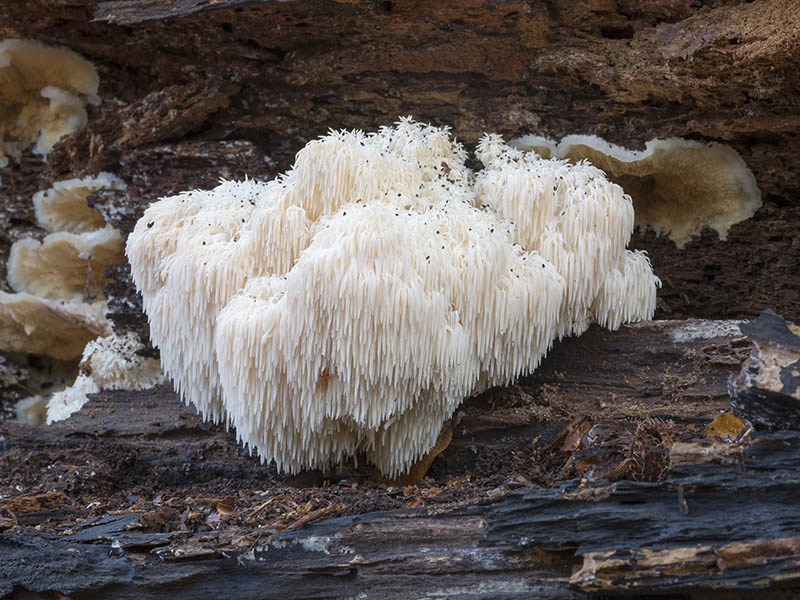
Lion’s Mane mushrooms have a medium to large size with the caps’ diameter can go up to 10-25 centimeters, and they cover all the stem. This type of mushroom will change from bright white to pale brown-yellow as it matures.
Lion’s Mane mushrooms have a tender and chewy texture with a seafood-like flavor. Some even compare them to lobster, crabs, or scallops. That’s why they are very popular with the people looking for a seafood substitute.
Maybe because they absorb all the nutrients from the host plants, they are very nutritious for their small weight. Lion’s Mane mushrooms contain lots of calcium, potassium, zinc, and most especially, beta-glucan polysaccharides, which efficiently protect the overall health of your body.
Lion’s Mane mushrooms are widely used as medicine in Asian countries. They are used as supplements to treat anxiety, reduce inflammation, and boost the immune system. Some countries in Asia use Lion’s Mane to apply on physical wounds to heal faster.
Being loved by the health benefit is once, they are also loved for their tastiness. They are usually served as sauteed in pasta, stir fry, soup, or stuff in sandwiches. The mildness in these mushrooms makes them suitable for many dishes.
But remember that these mushrooms have a very spongy texture, so don’t soak them in water. You don’t want them to be water-logged, right?
Because of their natural traits, they can only be stored for a few days in the fridge, or if you are unsure about freezing mushrooms, just do it because freezing them can lengthen the time.
Make a delicious crab cake from scratch with Lion’s Mane mushrooms.
15. Black Trumpet Mushrooms
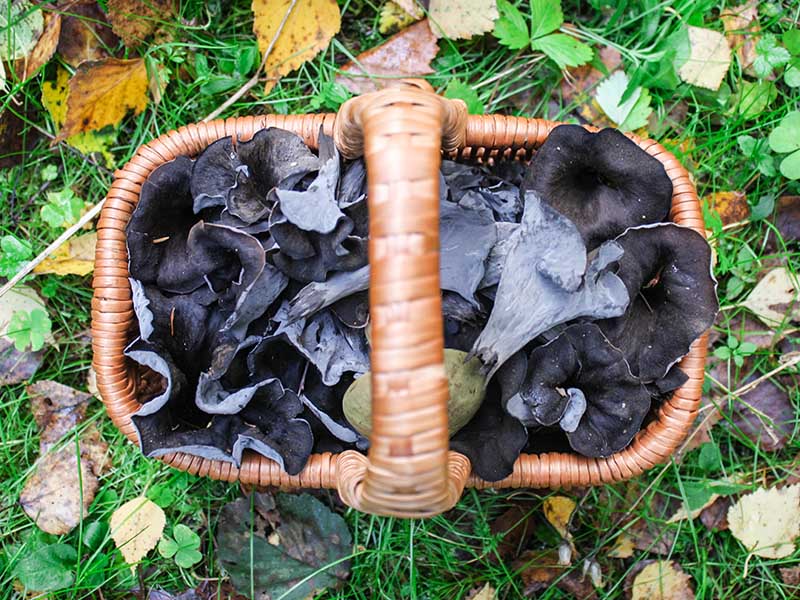
Black Trumpet mushrooms are usually found in small sizes, with the height of 2-15 centimeters and signature vase-shaped caps. They have a color range of brown, black to a gray color with a very thin and smooth, almost suede-like texture.
On the smell side, Black Trumpet mushrooms have a unique sweet and earthy aroma. In contrast, the taste of these mushrooms is more staple with a chewy texture and flavorful nutty and smoky taste. After all, they’re compared to Truffles for a reason, right?
Black Trumpet mushrooms are not as expensive as the real Truffle because they are not rare. They’re available all year and can be commercially cultivated, so you can find them anywhere. Especially during spring because it is the peak season.
These mushrooms are very high in nutritional value, especially with vitamin B12. This vitamin plays an important role in keeping your brain and nervous system healthy. What’s more, these mushrooms have high antioxidant levels.
Black Trumpet mushrooms are compared to poor men’s Truffle in Europe because of the nutritional values and their appearance after being cut. In terms of flavors, Black Trumpet mushrooms resemble the “golden mushrooms” the most when being dried.
But how should you cook these mushrooms? Well, I will teach you right away! Black Trumpet’s flavor is unique and delicate, so to not overpower the mushrooms, let them be the “main characters” by serving them alone.
Slightly sautee them and place with lighter flavor dishes like soup, pasta, or risotto. Keep in mind that these mushrooms pair well with garlic, caramelized onion, and herbs like chive, thyme. And if you want to pair them with meat, I highly recommend salmon, rabbit, or ham.
But if you want to feel the luxury taste of Truffle, try using the dried Black Trumpet mushrooms. All you need to do is crumble them into your food, and you have the perfect condiment for both savory meals and desserts.
16. Button Mushrooms
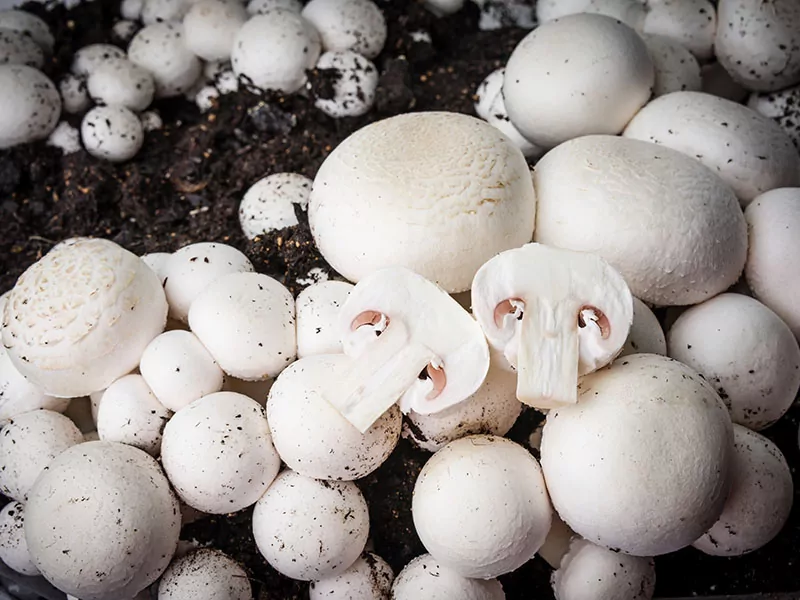
Button mushrooms, otherwise called White Button mushrooms, are small to medium with an average cap of 2-7 centimeters. But the stems are quite short compared to their overall size. Button mushrooms bring a firm and spongy feeling with pale white color.
These are the most common type of mushrooms on the Western market right now. But that doesn’t mean their taste or texture is average at all. In fact, Button mushrooms are very tasty and versatile for many dishes. Well, they are widely consumed for a reason, right?
Button mushrooms have a dense, thick, and smooth texture in general. When they’re cooked, they have a crispy texture with a mild umami taste. But these mushrooms are better when cooking because they will bring out the earthy flavor and a chewy texture.
They are also known for their nutritional values, and they have one of the most nutrients in the Parasite families. Button mushrooms are especially rich in antioxidants, vitamin D, amino acids, zinc, and so much more. All in one piece of mushroom, can you believe it?
These mushrooms suit many different types of cooking. You can turn them into stuff for your tarts, topping for your pizza, or even eat raw in a salad. They pair very well with multiple spices, such as garlic, ginger, lime, parsley, basil, etc. So be creative!
A heart-warming vegan Masala recipe with Button mushrooms.
17. Cauliflower Mushrooms
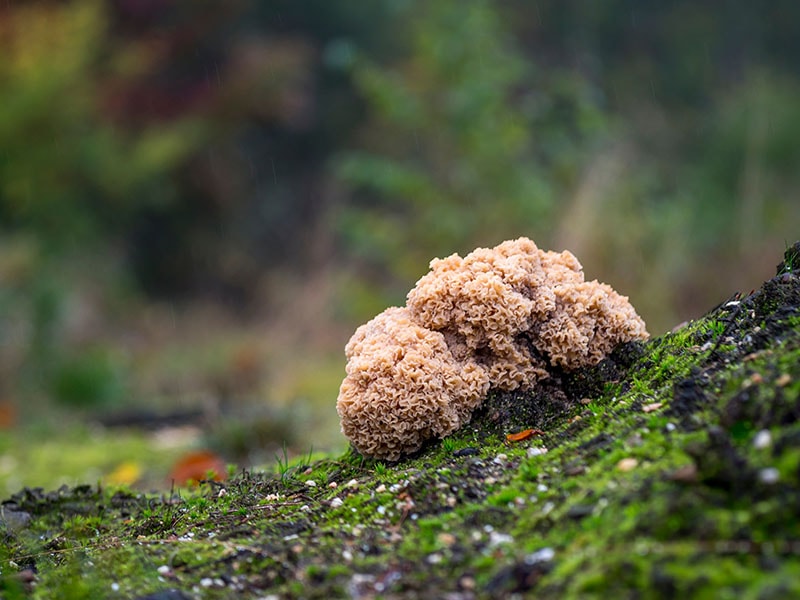
Exactly as their name implies, they look like cauliflowers, but some in earlier times seemed to disagree with that. That’s why they can also be called Noodle mushrooms, Wood mushrooms, or even Rooting Cauliflower mushrooms.
Cauliflower mushrooms are capless fungi with sizes varying from 10-30 centimeters. Based on their maturity, their colors can change from ivory, yellow to white. These mushrooms bring a smooth and waxy texture.
This type of mushroom has a signature smell of strong musk and earth before cooking, with a chewy and semi-firm texture. But once cooked, they will have the subtle nutty flavor, almost almond-like, along with the original earthy and neutral taste.
Cauliflower mushrooms are rich in nutritional values, especially with the parasol, which contains antifungal and natural antibiotics. Another precious value is the beta-glucans, a type of fiber working to improve the immune system, heart health, and lower cholesterol.
Cauliflower mushrooms taste best in cooked dishes, specifically for boiling or sauteing. In Asian cuisine, they’re put in soup, together with red meat and veggies. The Cauliflower mushrooms will absorb the broth and change into the texture of the thin egg noodles.
This type of mushroom used to be rare due to their solitary environment during fall and early spring, but now they can be fully cultivated year-round, so they are very cheap. Now that you don’t have to worry about the price anymore, try them now!
18. Common Ink Cap Mushrooms
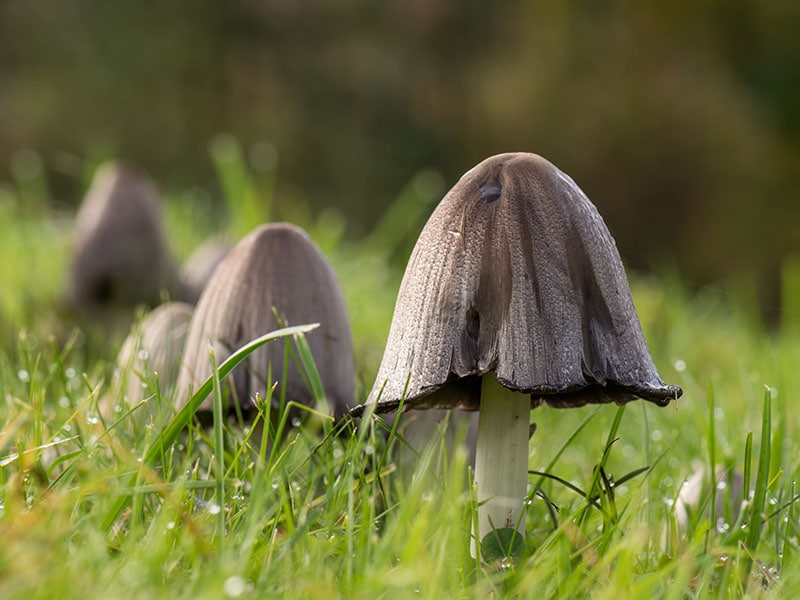
These mushrooms are found in small sizes, with a cap’s diameter of around 3 – 10 centimeters. They initially have bell-shaped, but the caps will slowly split over time. Common Ink Cap mushrooms have a signature brown color throughout their maturity.
Common Ink Cap mushrooms have a different taste of earthiness. They are combined with a bit of a mild creamy taste when cooked. Keep in mind that these mushrooms are classified as half-toxic. So to ensure, please don’t eat them raw.
The reason why these mushrooms are classified as poisonous is that they react severely with alcohol. Some of the symptoms are nausea, vomiting, malaise, palpitation, etc, and these usually appear 5-10 minutes after consumption. Be cautious while you can!
But apart from some risky reactions, Common Ink Cap mushrooms are very nutritional. They’ve been scientifically proven to be antioxidants, decrease the spread of cancer tissue, and even anti-inflammation. So why not give it a try now?
The Common Ink Cap mushrooms are very spongy, so they will lose the crunchiness in a short time and absorb the water very quickly. The only tip here is to cook them as soon as you get them. And try the dry dishes like saute, stir fry, or put in an omelet, you will fall in love!
19. Cremini Mushrooms
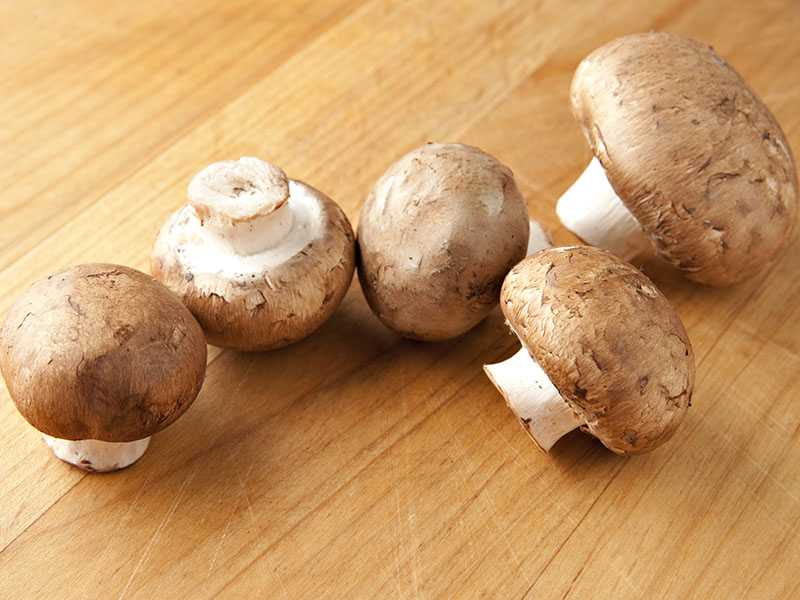
A very common mushroom on the market and a member of the Parasite family – Cremini mushrooms. They’re one of the most consumed mushrooms on the market right now, mainly because they’re commercially cultivated. No more worrying about the price!
Cremini mushrooms have small to medium caps’ sizes with short stems. The color of the caps is light brown, almost almond-like, while the stems are pale white. This type of mushroom has a dense, thick, and smooth texture, along with a bit of chewiness.
The taste of Cremini mushrooms is pretty mild, but the earthy taste and meaty texture will always make them mesmerizing. Because of these natural traits, they are loved by chefs and home cooks all over the world. That’s why they are seen in many dishes.
Is it fine to eat mushrooms raw? Because of the mild taste, this mushroom type can be used both raw and cooked. You can either quickly mix them in the fresh salad for lunch or cook them with lovely herbs such as sage, parsley, basil and pair them with some meat: beef, pork, poultry, or cheese.
Cremini and Button mushrooms share their roots from Agaricus Bisporus, so they have similar textures. But in terms of flavors, Cremini definitely earns a win. You can use Cremini instead of Button in stuffed, baked, roasted, or stewed dishes. All is possible!
But the good taste is not all. They are also very nutritious. The Cremini mushrooms are rich in potassium, amino acids, vitamin D, zinc, magnesium, and so many other things. If they are this tasty and nutritional, what is your reason not to put them on the shopping list now?
A fun fact you may haven’t known, but in ancient Egypt, Cremini mushrooms were believed to bring you special powers or eternal life. While in Rome, they were considered “foods of God”, and in Russian and Mexican tradition, they were a source of superpower.
So, is that enough for you to try Cremini right away? Because to me, it does!
You can’t stop eating this classic and delicious Cremini mushrooms with steak recipe.
20. Spring King Bolete Mushroom
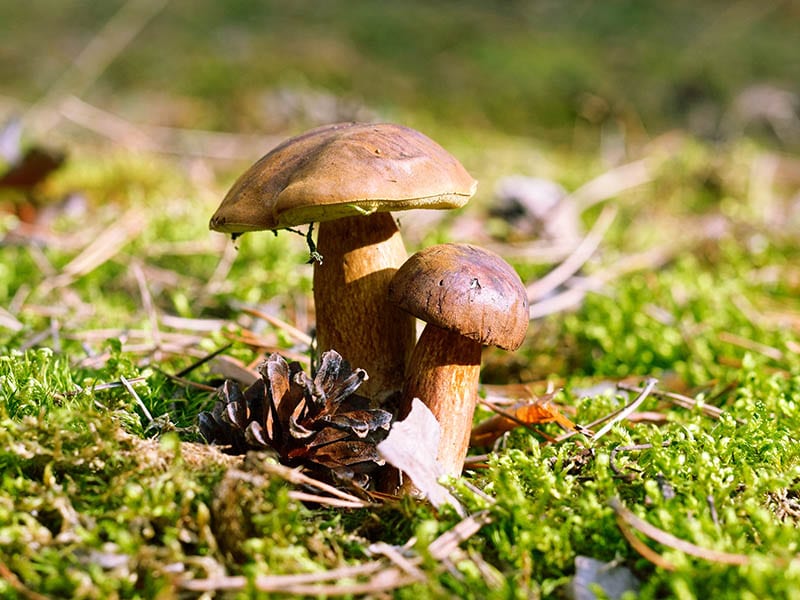
Spring King Bolete is a cousin to the famous Porcini mushrooms. They might not be as popular as Porcini, but they are compatible in terms of taste, texture, versatility, and nutrients. So does that make you want to try them now?
These mushrooms can be found blending to the ground under the pine tree from May to June, so you need the patience to gather them. They have pink-brownish caps with thick white stems. Their tastes are nutty and earthy, similar to Porcini but milder.
They also have a firm and chewy texture, makings them perfect for sauteeing, soup, or pickled. Or you can dice them and use them as topping to pizza, pasta, risotto, etc. However, they are porous, so don’t let them in water for too long and use them as soon as possible.
Spring King Bolete mushrooms are very low in carbohydrate and fat but rich in protein, so they’re perfect ingredients for a low-carb diet. At the same time, they’re a rich source of amino acids, iron, calcium, and magnesium.
21. King Oyster Mushroom
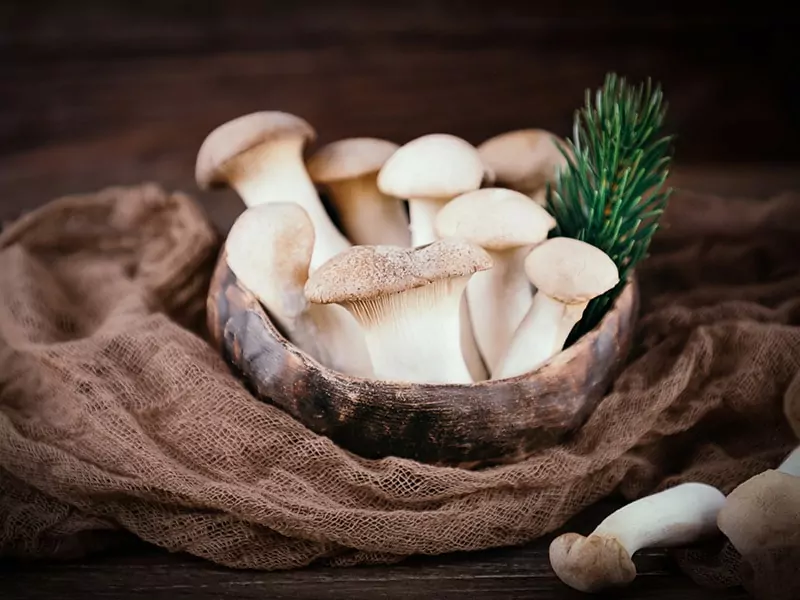
King Oyster mushrooms have thick stems with a bit curvy, smooth caps. The colors of these mushrooms are a mixture of white and creamy colors. In some mature mushrooms, the color can be deeper and more brownish. Their height can reach 12-17 centimeters.
These mushrooms have a dense and chewy texture. But when they are cooked fully, the texture would turn tender and meaty, along with the mild earthy, umami flavors.
Because of the natural meat-like texture and taste, King Oyster mushrooms are used as a meat substitute in many ways. You can choose to put them into sautee, soup, pasta, or even eat raw with salad if you want to.
But what if you like to make dessert, King Oyster mushrooms can also be used in mousse or brownies. So let your creativity decide! They’re versatile ingredients, so you can pair them with different foods: cheese, poultry, beef, garlic, onions, bay leaves, and many more!
But before that, want to check their nutritional benefits? Of course, you do. These mushrooms are rich in vitamin C, D, fiber, and niacinamide. But that’s not all, they also have a lot of iron, potassium, and folate. Tasty and nutritional, are you seriously not gonna try?
Vegan scallops? Yup, make your scallops from King Oyster mushrooms.
22. Parasol Mushroom
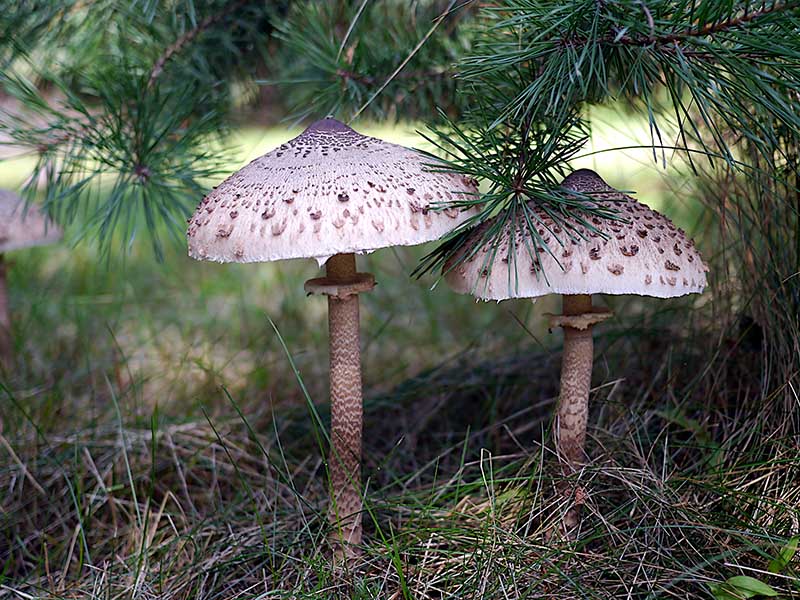
Parasol mushrooms are very tall, up to 40 centimeters. They have an egg-shaped cap but slowly open to the umbrella-shaped when mature. These mushrooms have many brow dots on their white caps, while the stems are fully brown.
Because of their unique shapes, Parasol mushrooms were thought to be the fairies’ umbrellas or dining tables. That’s why you will see a lot of artwork and fairytales that feature these mushrooms.
These mushrooms are well-known for their rich umami and nutty taste. The texture’s soft, which makes them suitable for many dishes. But the highlight is the strong, sweet, almost syrup-like aroma, and the smell will become stronger as they mature.
Not only are Parasol mushrooms tasty, but they’re also good for your health. They provide lots of vitamin D, copper, zinc, and fiber. What’s more? They also contain antioxidants and antimicrobial substances.
But before you go, please know that these mushrooms can’t be eaten raw, so don’t forget to cook them thoroughly. You can try to add to soup, omelet or make them into stuffing and tempura. Parasol mushrooms’ taste is levitated with herbs: oregano, parsley, rosemary.
23. Dryad’s Saddle
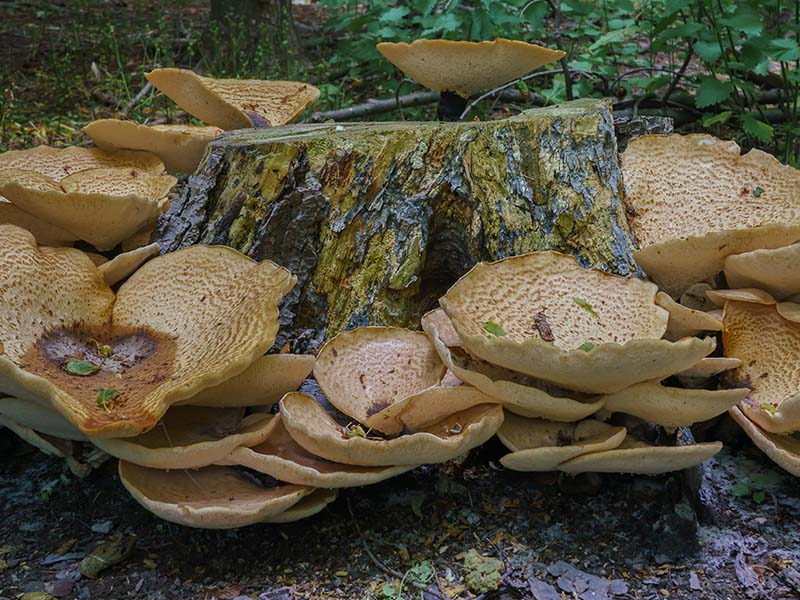
Dryad’s Saddle mushrooms, so far, are the biggest mushroom in the world with the capsize’s diameters that can go up to 70 centimeters. They have a fan-like shape with yellow-brown color that can easily be identified on dead or dying trees.
Their texture is very hard, even when you’ve already cooked them. So try to find the mushrooms that are still young with nugget-like size so they would be softer. They have the smell and taste of fresh cucumber, with a slight hint of apricot. Why not give it a try?
Not to mention their nutritional values. They provide plenty of essential nutrients such as vitamin B, C, D as well as phosphorus, potassium, and selenium. Dryad’s Saddle mushrooms are also good for your cholesterol and fat control.
The real question is how to cook these mushrooms? Shape the outside skin of Dryad’s Saddle and slice them as thin as possible. And don’t sautee or sear them because it would make them tougher and drier.
You should totally add them to the broth of your soup, stew for more flavor. Or you can cook them with butter and wine, wait till the water evaporate, and is done. You have a delicious dish of Dryad’s Saddle. Challenge yourself with new ingredients and new recipes!
24. Honey Fungus Mushrooms
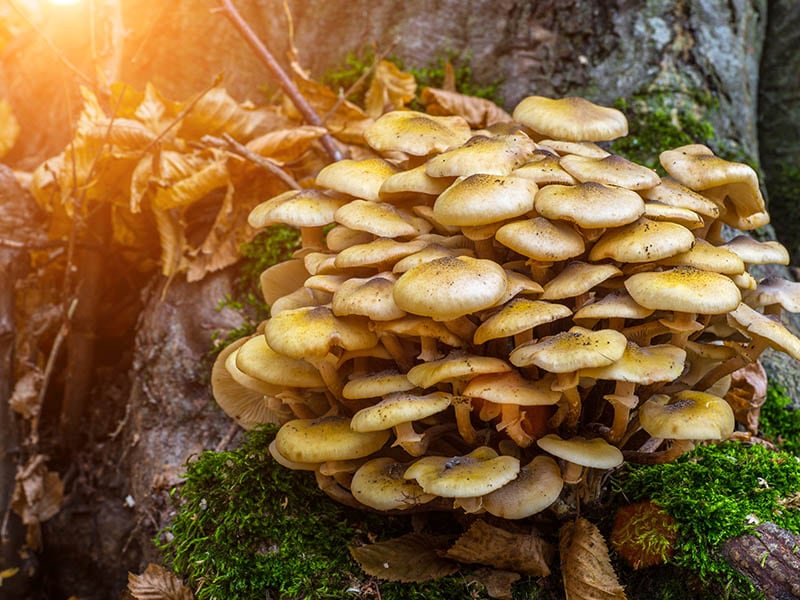
These mushrooms might be small in size, but they make up with the quantities. They can grow a lot within a short amount of time and have no problem sucking out all the nutrients on their host plants.
Honey Fungus mushrooms usually grow in a cluster with the signature caps’ color of warm honey. They also have a unique white ring around the stem. You can easily identify them around the dead tree roots in a huge amount.
This type of mushroom has quite an acidic smell and taste with a hint of sweetness in the end, along with the chewy texture. Perhaps this’s the reason why not many want to include them in their daily meal. But that’s because they didn’t cook them right.
Honey fungus mushrooms will neither taste good nor healthy if you undercook them. So try boiling them for 15 minutes before cooking or soaking them in salt water for 30 minutes. After that, treat them like any normal mushrooms, and you will find beauty in them.
Because these mushrooms can be really slimy after boiling, they suit perfectly for soup, saute, and any watering dishes. But keep in mind that, even when you boil them, the toxins are still there and can cause you sick. So only use a small amount at first to be sure.
On the other hand, make sure you know some tips for recognizing spoiled mushrooms for safe consumption.
Despite all of that, they are quite nutritional because research shows that they’re rich in antioxidants substance, enhance your brain strength and stabilize your sugar level. So don’t let the stigma stop you from enjoying these mushrooms, of course, only if they don’t kill you.
A Crowded Family With 16 Members From Saprotrophs
The family with the most edible members – Saprotrophs. They would decompose important organic compounds and use that as nutrients for the next growth. It’s possible to say that Saprotrophs is an overlap of Mycorrhizae and Parasite.
Because when the host plants die, there’s no more long-term food for the Parasite mushrooms, and they would die sooner or later. That’s the moment for Saprotrophs to shine, and they will use all the dead matter to rise.
That’s why some mushrooms are seen as both Parasite and Saprotrophs, like Cremini mushrooms or Button mushrooms, because they can thrive in both conditions.
25. Chicken Of The Woods Mushrooms
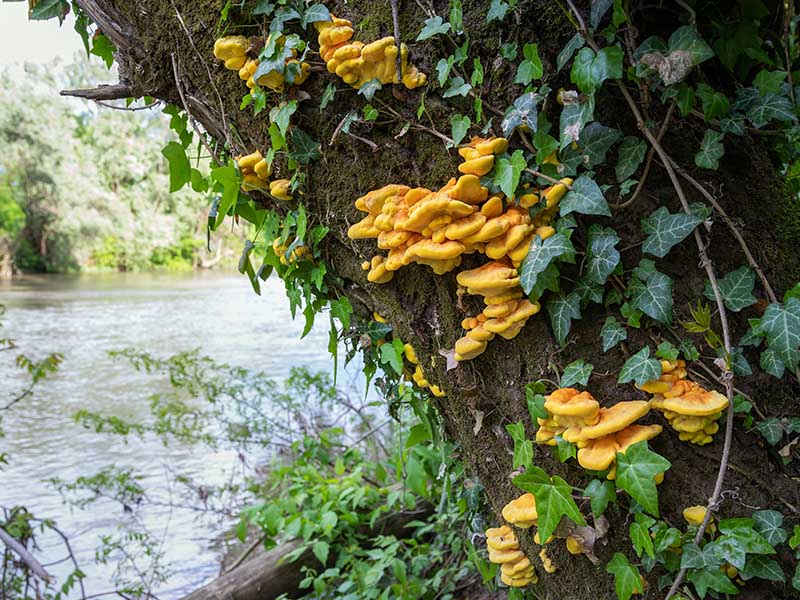
Chicken of the Woods mushrooms has a medium to large size, with an average diameter of up to 25 centimeters. The shape is like a fan with an eye-catching, bright yellow-orange color tone when they are young, but after they reach maturity, they will turn fully white.
These mushrooms have a suede-like texture with rounded edges. They taste the best when cooked because the texture will then become juicy, succulent, and meaty. The flavor also shows the umami taste, with a hint of mild lemon flavor.
A warning before we dive deep into these mushrooms: Chicken of the Woods mushrooms can bring you an allergic reaction, especially if you are new to these fungi. The tip here is to start with a small amount and let your body decide whether they like it or not.
The chicken-like flavor is one of the reasons why they are well-loved by many chefs and vegetarians in the world. Just simply cut them into bite-size pieces and saute them with butter and herb, and you’ve already had a delicious dish for dinner.
These mushrooms pair well with asparagus, fiddlehead ferns, peas, spinach, etc. Feel free to experience any new recipes because they’re very versatile. But remember not to soak them into the water while cleaning because they will easily get water-logged.
All taste aside, the nutrients of Chicken of the Woods are very mesmerizing. They’re rich in potassium, vitamin C, vitamin A, and fiber. Current research shows that they’re good material for antifungal and antibiotic use.
Actually, in ancient Russian, they were dried and minced into powdered to use as natural antibiotics, at the same time, to boost the immune system. Good thing these mushrooms can be home-cultivated now, so why not give it a try?
KFC chicken from Chicken of the Woods! Where are all my vegan friends?
26. Wood Blewit Mushroom
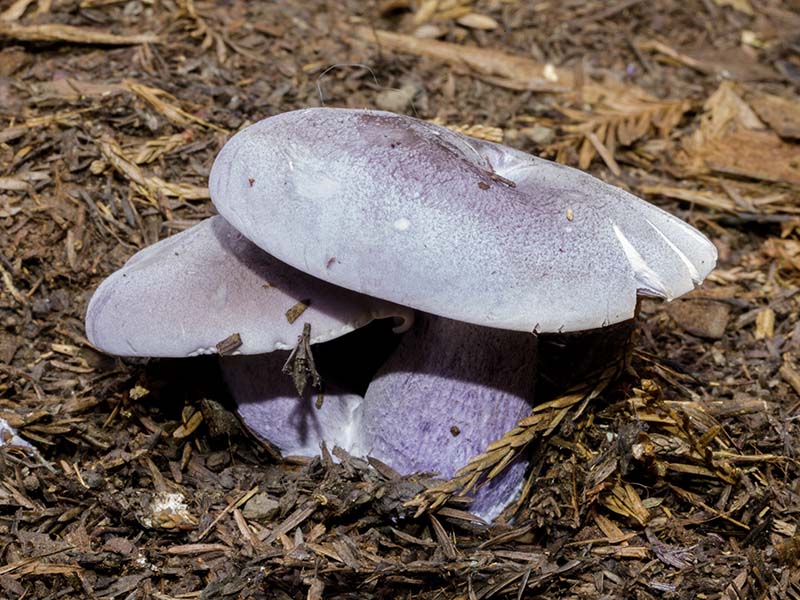
Wood Blewit mushrooms, also called Blue Foot mushrooms, have flat caps with thick stems. What is unique about their appearance is the deep lilac colors on the stem. Because of the special colors, they were believed to be fairies’ places in European folklore.
Beautiful as they look, Wood Blewit mushrooms must be cooked thoroughly, or they will cause health problems like nausea, headache, vomiting, and so much more. But don’t worry, cooking would only make these mushrooms more delicious, no less.
Wood Blewit mushrooms suit a lot of recipes such as roasting, grilling, sauteing, and more. But it’s sad to say that the blue-lilac colors will disappear under the heat effect. But they’ll enhance the original chewy texture with earthy flavor so try them as a meat substitute.
These mushrooms especially go well with meat and seafood, so you can pair them together. Along with some extra seasoning like masala, onion, garlic, or parsley. You can saute, grill, or use them as topping and side dishes, all you want as long as you boil them first!
The beautiful lilac color on Wood Blewit mushrooms actually comes from polysaccharides, also known as carbohydrates. But this isn’t their only healthy nutrients; they also have vitamin B1. This helps to regulate sugar levels and protect your nervous system.
27. Enoki Mushrooms
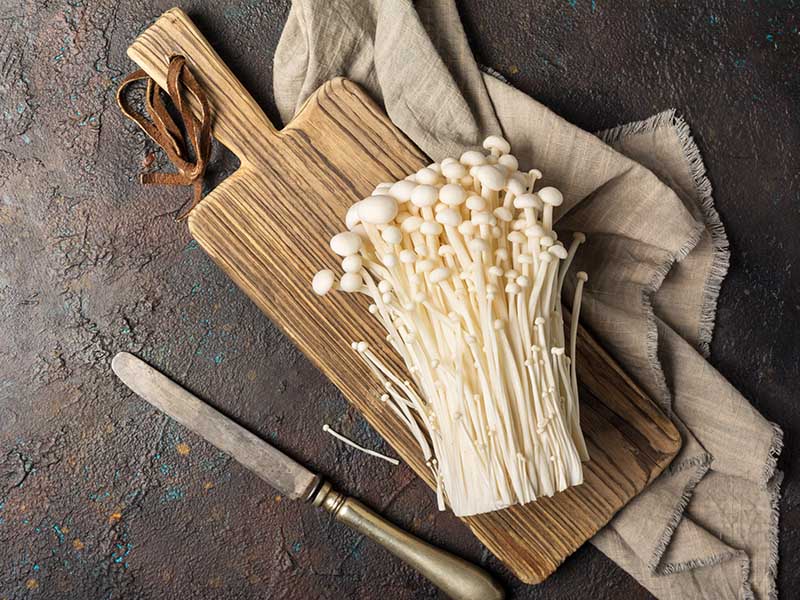
A very signature mushroom in Asian cuisine, so you will see them in a lot of traditional dishes, especially for Eastern Asia. The Enoki mushrooms found in the markets have slender white stems with petite caps and are usually packed in a cluster.
But in the natural environment, they have larger caps with short stems with a brownish color. But the taste is quite similar in both conditions, as they have a crispy, firm texture with a mild fruity flavor. Yet, the natural Enoki mushrooms will taste a bit earthier.
Enoki mushrooms have a lot of fiber, calcium, potassium, iron, copper, and a lot more nutrients. They’ve been used as a traditional herbal medicine for anti-inflammation and to boost the immune system.
Enoki mushrooms suit both raw and cooked. You can put them raw into a salad or sandwich and enjoy its freshness as well as crispiness. But in Asian countries, they’re loved to be added to the soup with everyday ingredients: soy sauce, green onion, fresh herbs, etc.
If you want to add some meat in, that’s a great idea! Because of the mild fruity taste, they go very well with seafood like crab, lobster, and shrimp. But feel free to add other types of meat like beef, pork, or chicken.
Rice with meat wrapping Enoki mushrooms – the genius combination for winter.
28. Yellow Knight Mushroom
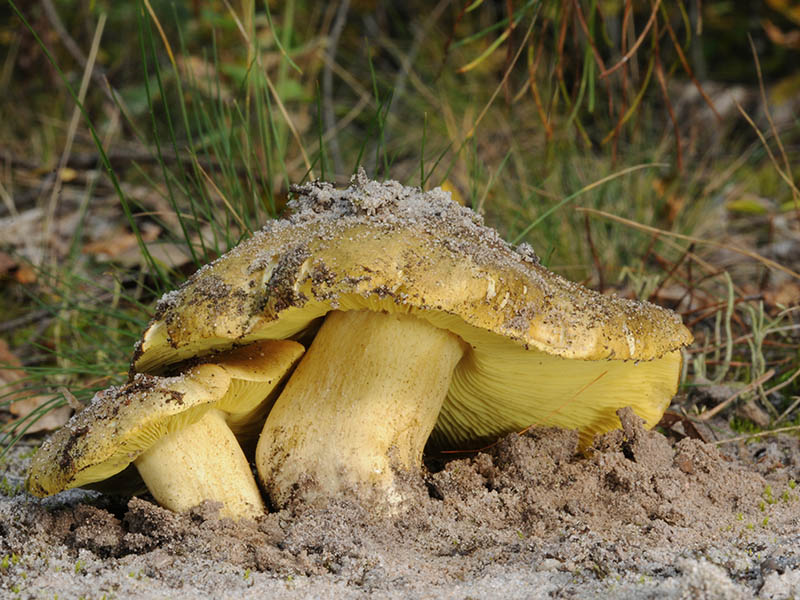
Yellow Knight mushrooms, another name is Man on Horseback mushroom; are famous for their similar look to Sulphur Knight: signature bright yellow, thin stems, wide-open caps. The Sulphur Knight mushrooms are poisonous, so learn their differences between them now.
Sulfur Knight mushrooms have an acidic, mixing with coal gas that can irritate people. But, Yellow Knight mushrooms have a mild earthy smell, some even say they don’t have any smell. The colors go from yellow to brown as they go down to the bottom, with a sticky texture.
They might not be as dangerous as your cousin “Sulphur King”, but they sure also have some problems. There’ve been reports on muscle pain after using these mushrooms undercooked, so don’t forget to heat them up thoroughly before using them!
Poisonous as they may be, Yellow Knight mushrooms actually have some valuable nutritions. They have a good amount of fiber to support the digestive system, magnesium, vitamin C, D, and other minerals. Doesn’t that make you curious about these mushrooms?
But still, only eat Yellow Knight mushrooms if you have no allergic reaction, which means no taste test. But if there’re concerning symptoms, such as nausea, vomiting, excessively sweating, I think it’s a good time to get professional help.
29. Giant Puffball Mushrooms
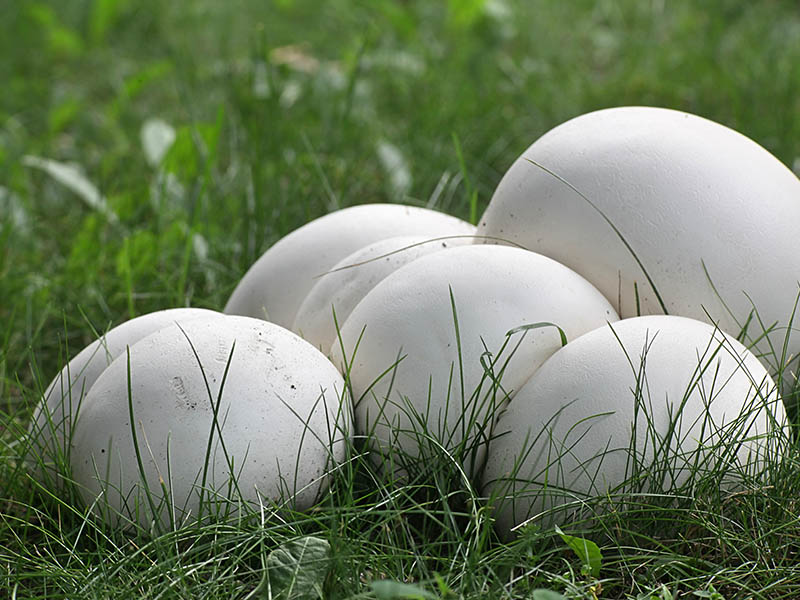
Puffball mushrooms, in general, are a common name for the Basidiomycetes family, which can vary in size. However, today we are talking specifically about the biggest one, which is the diameter around 30-70 centimeters. That’s why they’re called Giant Puffball mushrooms.
The recorded largest Giant Puffball mushroom has a diameter of 1 meter and weighs 50 pounds. Of course, not all the Giant Puffball mushrooms have this size, but they are still very big compared to other types of mushrooms. That’s why many chefs love them!
These mushrooms usually have very smooth caps with a firm, spongy texture. When you cut them into half, the young flesh would be pure white. But if they are already mature, the color would be yellow-brown instead. And at this stage, they are inedible.
Being big and having good flavors are not the only reason the Giant Puffball mushrooms are so loved. Another reason is that they contain a lot of nutritional value. Some of them are phosphorus, selenium, clavacin, and manganese.
But notice, you can only eat these mushrooms when they’re still young. And they will have the signature nutty and earthy flavor, which suits a lot of different dishes. So you can try them in many different recipes.
These mushrooms work the best with cooking applications so sauteing, frying, or baking would be a good decision. Many also give these mushrooms the nickname “breakfast mushrooms” because they suit many simple and hungry breakfasts.
You can dice them to stir fry with other veggies or put them into the sauce, soup, or risotto. Using them as stuff for the sandwiches or blending into hummus are also lovely ways to eat these mushrooms. But keep in mind that they have a spongy texture, so don’t keep them for long.
Giant Puffball Mushroom can’t be fast food? Try this double cheeseburger recipe.
30. Red-Capped Scaber Stalk Mushroom
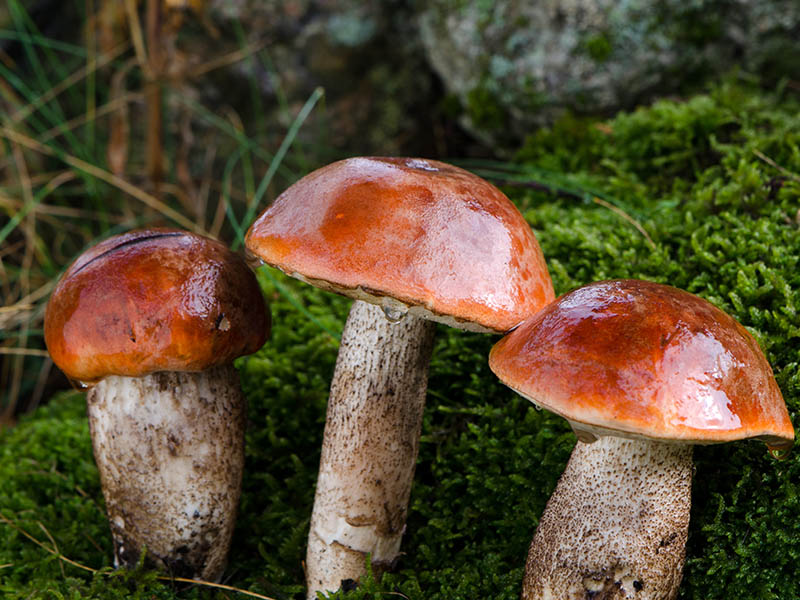
Red-Capped Scaber Stalk mushrooms are easy to recognize with very big red caps attaching to their thick, white stem. Maybe that is how they earn their names. These mushrooms’ caps have smooth skin with firm textures and a mild earthy taste.
These mushrooms are still very debatable whether they’re edible or not. However, recent research shows that if you cook them thoroughly, the chance of you having an allergic reaction would be lower, and the symptoms would be lighter, such as irritated gassing or dizziness.
But still, even when you cook them well, there is still a chance you can have a serious allergic reaction. The reason can be because you eat too much at once, or you undercook them. So always start with a small amount first and see how your body reacts.
You may also mistake between the red and the orange, so here’s the tip for you. Stay away from the orange one. They are actually poisonous and would kill you in a blink even when you have boiled them on fire for 2 hours. Just don’t try them at all.
But aside from the fact that they can be intoxicated, the nutritional benefits they provide are also great. The Red-Capped Scaber Stalk mushrooms contain a lot of fiber to help your digestive system, antioxidants, phytonutrients, and minerals.
You will need to pre-boil these mushrooms for 15 minutes before cooking them. After that, don’t hesitate to add them into sautee, soup, stew, etc. Or you can boil them longer to destroy the toxin and use them with sauce. Their mild taste is actually charming.
31. Maitake Mushrooms
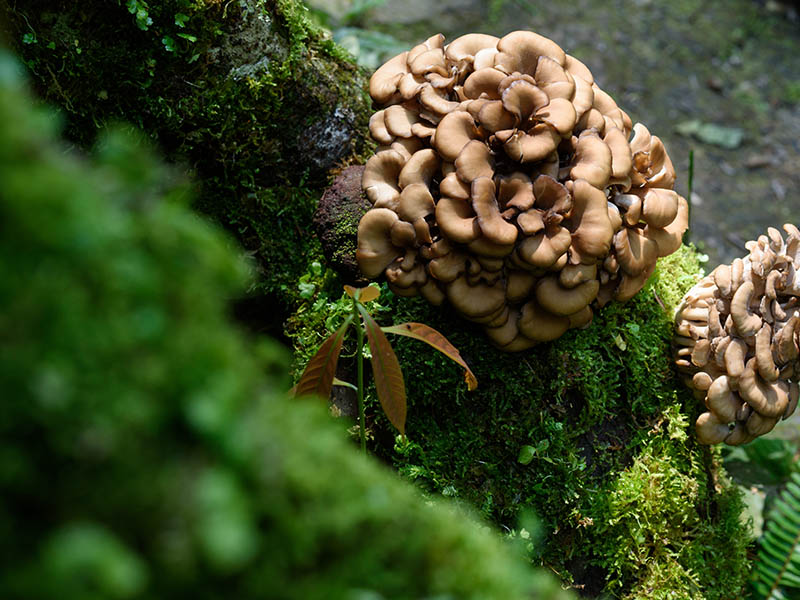
Maitake mushrooms in Japanese means “Dancing mushrooms”, all thanks to their natural flowy shape. But you can also see some different names such as Hen of the Woods, Ram’s Head, or Sheep’s Head. Pick your favorite name for these mushrooms!
Maitake mushrooms have a chewy and slightly firm texture. The flavors of these mushrooms are smokey, earthy, with a hint of umami in the end.
But there are differences between dried and fresh mushrooms. When you use the dried Maitake, the flavors will also be mixed with ginger, clove, and cinnamon.
This type of mushroom is not only tasty but also high in nutrients. They are rich in vitamin D, antioxidants, and beta-glucan. These mushrooms are also rich in potassium, which helps to the fluid level in the body, along with fiber to regulate the digestive system.
It’s time to find out the best way to eat the Maitake! With the strong flavor, they especially suit soup and stew, but you can also saute and add them to the omelet, but bite-size areas a topping to the pizza or pasta, or even bake them.
Maitake mushrooms are now widely used across the world, but they are the most popular in Japan. In old age, they are used as currency in exchange for silver. Even though they’re cultivated now, they remain their values and become a precious gift for families.
Simple Maitake mushrooms tempura for a snack.
32. Slippery Jack Mushroom
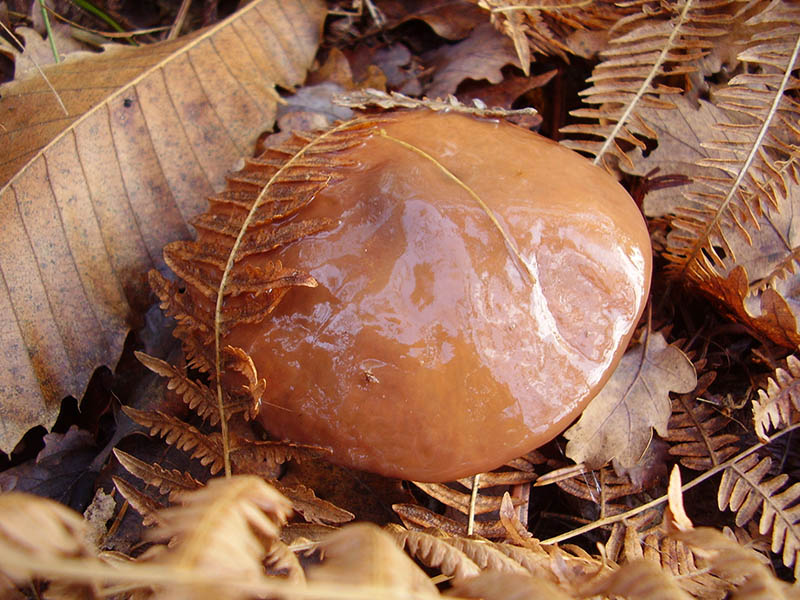
Slippery Jack mushrooms are widely spread during the summer and fall, but they thrive during the later season. You can tell from the name that they have a slime coating on top. But be careful, you need to remove them before eating as they can cause indigestion.
These mushrooms have a chestnut, olive-brown color with conical-shaped caps. When they are still fresh, the slime will be sticky to your hand. But when they’re dried, you can peel the slimy film out of the cap easily. That’s also the perfect time for you to prepare and eat them.
When you remove the slime, there will be a firm and dense texture. However, thoroughly cooking the mushrooms is always recommended, just in case there are still toxins within and cause an allergic reaction. But trust me, you will love the cooked Slippery Jack mushroom.
These mushrooms have a juicy texture, so they suit frying, adding to the stew, soup, risotto, or turning into stuffing. But pureeing them is not a good decision. Because they will turn clumpy, and the color won’t be appealing at all. But feel free to create and try how you want it!
Slippery Jack mushrooms are good sources of minerals: iron, zinc, magnesium, and also vitamin C, D. They are very low in calories, carbohydrates, and fat, yet, rich in protein. So if you’re looking for weight-loss-friendly ingredients, you know where to find them!
33. Morel Mushrooms
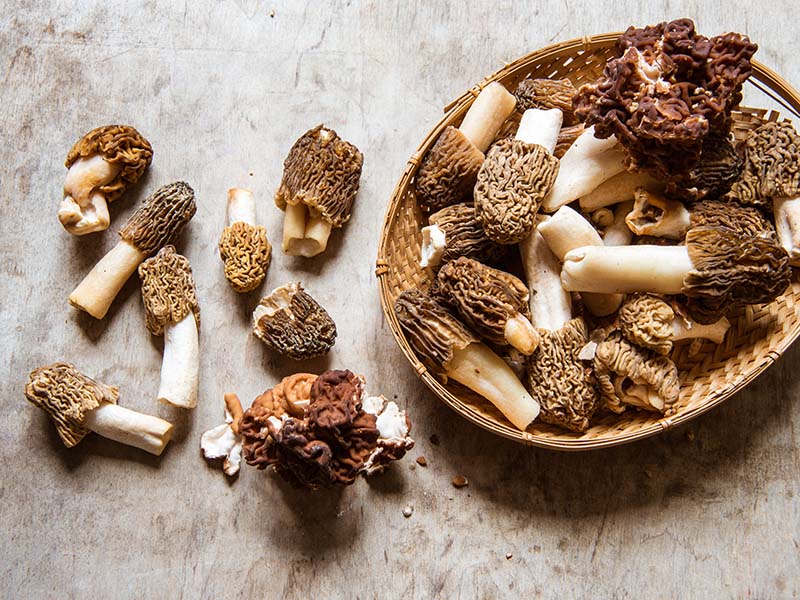
The average size of Morel mushrooms is quite small, with the caps’ diameter of 2-7 centimeters. They’re signature with the bulbous cap, attaching to white, stout, short stems. Yet, the color of the caps can be yellow, light/dark brown, or gray, depending on their age.
Another signature look of these mushrooms is the honeycomb-like holes on the exterior. One fun fact is that all these holes have different shapes and sizes, so they can be seen as the fingerprint of the Morel mushrooms.
Morel mushrooms are not recommended to eat raw. One reason is because of their toxins. The other is simply because they taste better when cooked. They will release the meaty texture with unique deep earthy, nutty, woodsy, and umami flavors.
The nutrients in Morel mushrooms are high in fiber, iron, magnesium, and calcium. With all these nutrients and tastiness, how can there be any complaints about the price!
But being nutritious and tasty are not enough to explain their high price. But their rareness can! The main reason for their high price is that they cannot be commercially cultivated and are only available during the spring.
Despite the rareness, they are still well-loved by all the high-class restaurants for their deep, signature flavors and high nutritional values. The recipes for Morel are usually minimal, so the natural flavors of these mushrooms can shine.
You can consider putting them into soup, pasta, risotto, or simply saute them and put them on top of the roasted meat. Or blend into the sauce and hummus are also good ideas. Morels go well with onions, shallots, garlic, lemon juice, and meat like sausage, bacon, pork, beef, etc.
Classic and elegant pasta with Morel sauce. Easy and delicious for dinner!
34. Shaggy Mane Mushrooms
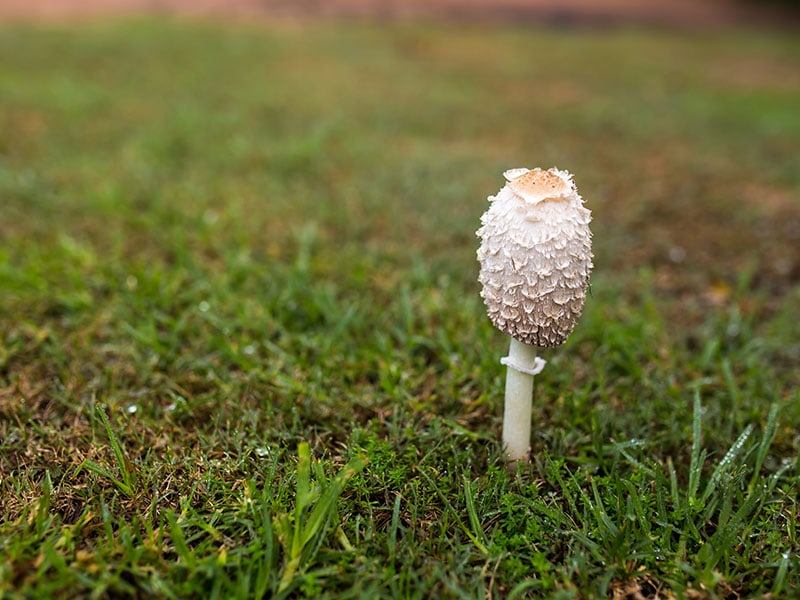
Shaggy Mane Mushrooms can be easily recognized, all because they have a cone-shaped cap with a shaggy texture. The mushrooms, in general, have pale white color, but the scale parts will have the gray or reddish-brown color, so you can easily see them from afar.
The texture of these Shaggy Mane mushrooms is unique because they get broken very easily. Like seriously, you just squeeze a little bit, and they disintegrate right away. So be extra careful when picking these mushrooms.
These mushrooms aren’t commercially cultivated, but you can easily find them during summer and fall. They grow and degrade easily, so you can find them in a large group in compacted soil after the rain. Consume them right after harvesting, before they dispose of them, is.
But keep in mind that they come from the same family as Common Ink Cap mushrooms, and they have the same toxins. Remember to not consume alcohol for at least 48 hours after eating the Shaggy Mane mushrooms. Better safe than sorry, right?
Apart from that one cautious, Shaggy Mane is a good source of potassium, zinc, and calcium, so feel free to use them.
But the nutritional effects aren’t all, their tastes are immaculate. In the book “Forager Chef”, Shaggy Mane mushrooms were complimented for the intense and “mushroomy” taste. The book mentioned the unique flavor change that only happens with these mushrooms.
Because of the special earthy and mild umami taste, these mushrooms are used in simple dishes like saute or pasta. They also pair perfectly with poultry, beef, pork, etc, and herbs. But don’t season with too much extra flavor, they will dim the light on Shaggy Mane.
35. Shiitake Mushrooms
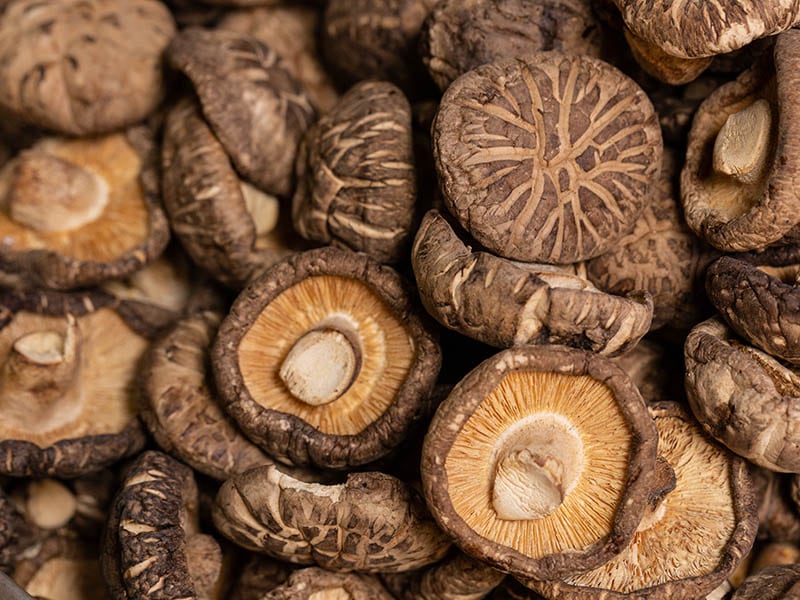
Shiitake mushrooms have the common caps’ size from 10-20 centimeters in diameters. The colors of these mushrooms range from light to dark brown, all depending on the maturity of the mushrooms. And the caps would attach to the short, white stems.
What makes them special is the unique smell and flavor after cooking. Shiitake mushroom will give out the garlic, with a note of pine tree aroma. They are also special with the combination of earthy, woodsy, and umami taste. The texture is chewy and meat-like.
Another reason why Asian cuisine loves these mushrooms so much is also their health benefits. They are full of vitamin A, D, C, and B12, but that’s not all. They are rich in calcium, copper, zinc, and magnesium. Are you curious how they are put into the cuisine?
In Japanese cuisine, Shiitake mushrooms are sliced and put into miso soup, stew, or vegan dashi. Or slightly stir-fry them and use them as side dishes. The flavor of Shiitake is signature, so just keep the recipe subtle with thyme, cilantro, soy sauce, sesame oil, etc.
How about this classic stir-fried Shiitake mushroom recipe for your dinner?
36. Oyster Mushrooms
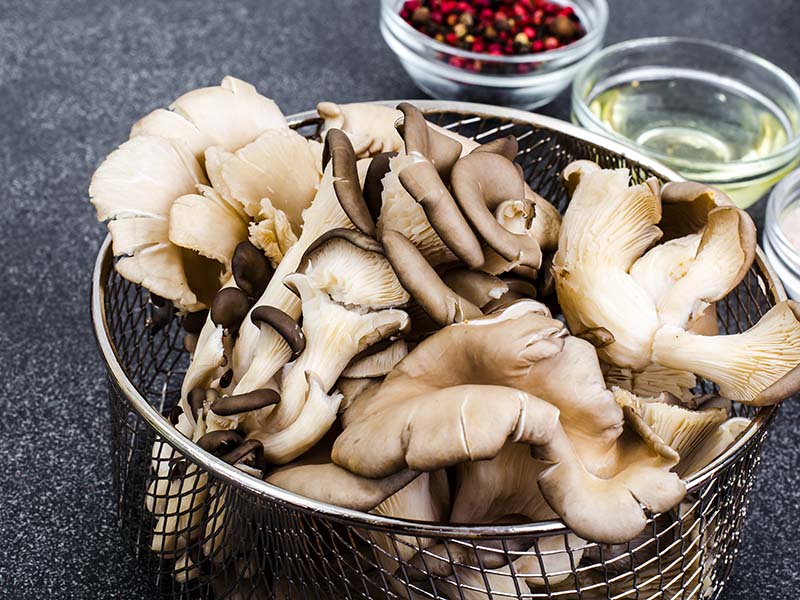
Oyster mushrooms are usually found with the caps’ diameters’ size from 5-25 centimeter mushrooms, which is pretty huge in the mushroom kingdom. They have short to no stems at all, with gray, brown, yellow, or pink fan-like caps.
The Oyster mushrooms have wavy edges, and they will become curvier as time passes. The shapes give the impression of an oyster, but that’s not the only explanation for its special name. The other reason is also because of the taste of this type of mushroom.
Oyster mushrooms have a chewy texture with the scent of anise. And the reason why they are named the “Oyster” is that they give out seafood flavor after cooking. And that’s perfect for vegans and vegetarians who are looking for a seafood substitute.
But before diving too deep, keep in mind that these mushrooms can cause allergic reactions when used raw. So cooking them fully is the best option. Well, better safe than sorry, right? But apart from that, they are very versatile and can be used in multiple dishes.
In Eastern Asian cuisine, these mushrooms are added to soup or stir-fry. But you should also try to deep fry the Oyster mushrooms and make them into tempura. Remember that these mushrooms turn soft quickly. So to keep the crispiness, add them at the end of the cooking.
This type of mushroom is very popular in Eastern Asian cuisine. So if you want to try some Asian, consider these ingredients to pair with: tofu, soy sauce, onions, shallots, and green onions. Use them as soon as you purchase, so you can get the best flavor.
One last note on the nutritional benefits; these mushrooms are very valuable for your health. They are rich in vitamin D6, potassium, fiber, and folate. Sounds great, isn’t it? But that’s not all. The research found the antioxidant in these mushrooms can decrease inflammation.
You’ll love these spicy stir-fried Oyster mushrooms.
37. Portobello Mushroom
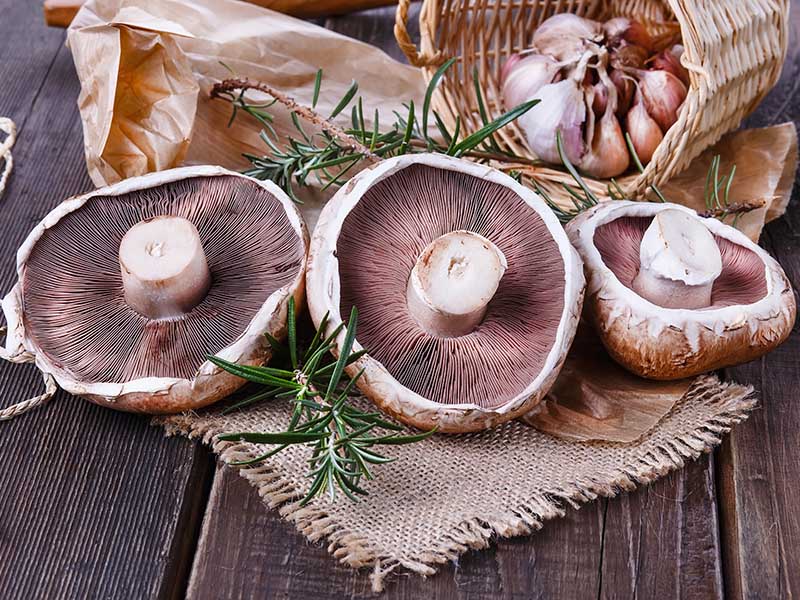
Portobello mushrooms are very popular on the market, so you must have heard of them once. But let’s just recap some features anyway. They have dark, brown caps with smooth skin; thick, white stems, and what sets them different is the black gills under caps.
These mushrooms are perfectly safe for you to eat raw. However, they taste better when cooked. Portobello mushrooms will bring a meat-like texture with rich nutty, earthy, and umami flavors. And for these special characteristics, they’re very versatile for many dishes.
You should try sauteing, boiling, grilling, or even baking for desserts. The stems suit being used as stuff or topping, while you can use the caps for any recipe. Here are some ingredients that can levitate your dishes: teriyaki sauce, pesto, garlic, meat, seafood, etc.
Portobello mushrooms are very nutritional with multiple vitamins C, D. They are also rich in fiber, niacin, phosphorus, and selenium. No wonder why in ancient Rome, people believed eating Portobello would give them the special power of eternal life, like a God.
All-in-one recipe of stuffed Portobello with cheese, spinach, and bacon.
38. Saffron Milk Cap Mushroom
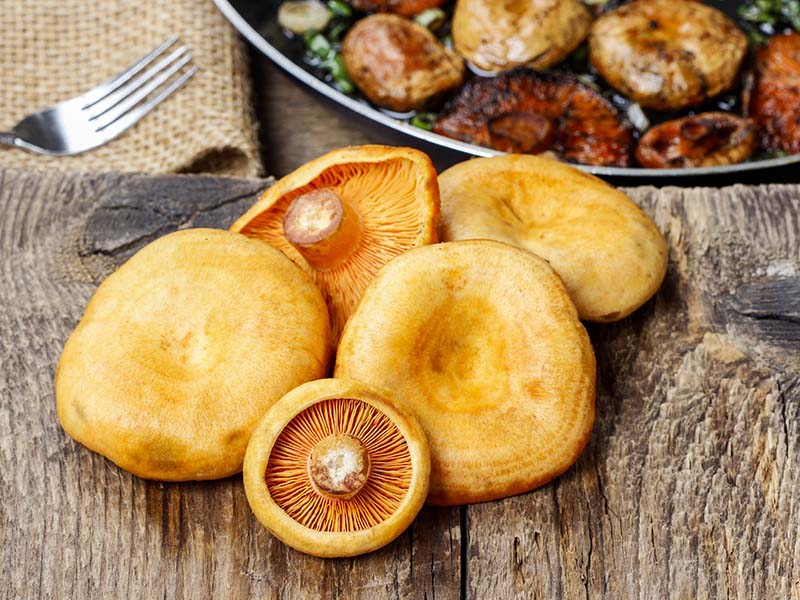
Saffron Milk Cap mushrooms come with a warm orange-yellow hue, with a smooth texture and flared edges. These mushrooms have a special granular surface. So, in dry condition, they will have velvety skin. But when wet, they become sticky.
These mushrooms have a firm and dense texture with a fruity aroma. The charming thing about the Saffron Milk Cap mushrooms is the taste. They have nutty, earthy, and woodsy flavors. If you notice latex-like liquid when cut, don’t worry, they’re safe to eat.
This type of mushroom is high in protein, iron, magnesium, sodium, and calcium. If you notice their bright color, it’s because they’re rich in beta-carotene. This nutrient helps keep your youthful skin, with one side effect being that your urine will turn orange or red.
Saffron Milk Cap mushrooms are safe to either eat raw or cooked. In fact, the Russian traditional recipe recommends slicing thinly the mushrooms, adding to salad some salt and olive oil, and it’s done. But you should also try to add them to pasta, soup, stew.
These mushrooms go well with all types of meat like steak, pork, lamb, poultry,… and herbs, such as parsley, rosemary, thyme. One more tip, wait till the mushrooms “bleed” the latex-like liquid so the smell can be more appealing and their natural color brighter.
A heartful sauteed Saffron Milk Cap mushroom recipe for busy days.
39. Straw Mushroom
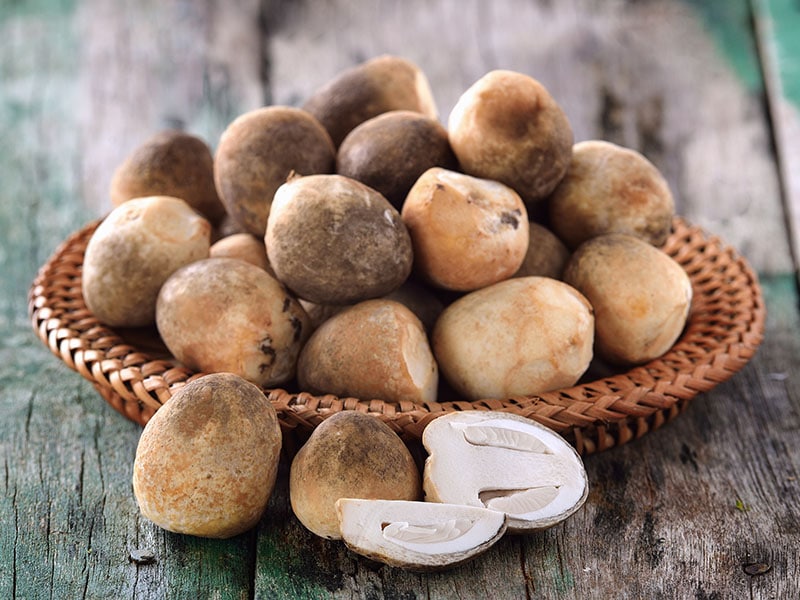
Since the early 18th century, Chinese Buddhist monks learned to cultivate mushrooms on paddy straws to use them in daily diets and medicines. The methods spread across Asia, and to this day, Straw mushrooms are popular in Buddhist diets and the Asian market.
These mushrooms grow in clusters with an oval shape, almost egg-liked. The colors of the mushrooms vary from dark yellow to cream and slowly change to gray or light brown when mature. Straw mushrooms have a velvety, soft texture with a mild musky, earthy taste.
These mushrooms are a great source of anti-bacterial substances, potassium to regulate and maintain blood vessel functioning, and also vitamin C, D, fiber, and amino acid. They were also used as medicine in Chinese culture to remove the heat from the body.
Straw mushrooms have mild, elegant tastes, and that makes them versatile in cooking. In Asian cuisine, they’re added to stir fry with noodles like chow mein, soup such as tom yum, or hot pot.
You can also dice them and use them as a topping or stuff for pasta, risotto, sandwiches or make them as a meat substitute for their light taste and chewy texture.
Keep in mind that these mushrooms pair well with lots of seasoning: turmeric, masala, cumin, ginger, etc. In this case, pairing them with red meat, poultry, or seafood is a great decision. And if meat isn’t an option, tofu and Straw mushrooms were born for each other.
40. Wood Ear Mushroom
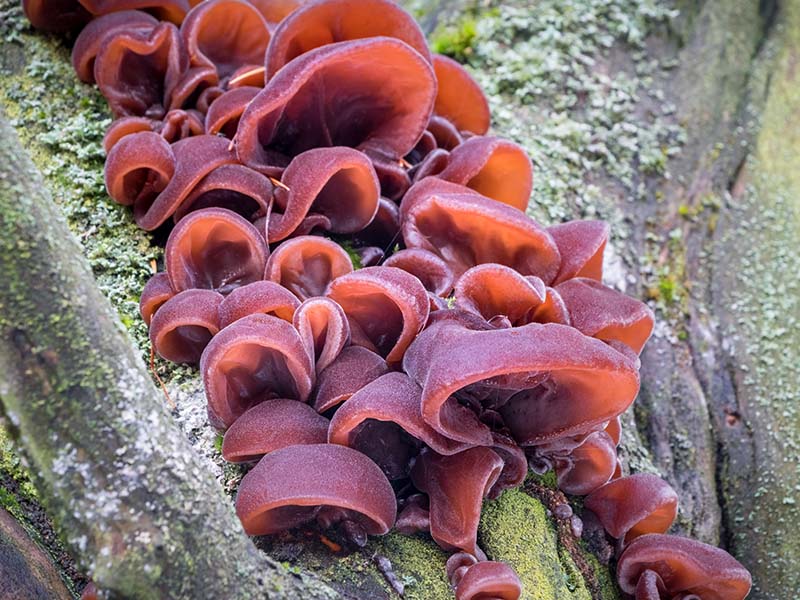
Wood Ear mushrooms have a curvy shape that reminded people of the ears, and that was how they earned the name. They have a dark brown color with slippery, gelatin-like slime on the skin. The textures of them are crunchy and toothsome with musty flavors.
On the market, most Wood Ear mushrooms are dehydrated so you need to soak them in water. After that, you can add them to salad, soup, or stir-fry any way you want. Add some soy sauce, vinegar, sesame oil, or cilantro, and they will level up your mushrooms dishes!
Since the Tang dynasty, Wood Ear mushrooms have been loved by the Chinese royalty for their tastiness and medical benefits. These mushrooms can help to soothe the sore throat, improve circulation and reduce fever. Till now, they’re still loved in Asian cuisine!
Warm yourself up with a bowl of chicken soup and Wood Ear mushrooms!
Extra Lesson On The Mushroom Family With Endophytic
This part will be about Endophytic – another mushroom family. Sadly, there is no exact find on edible mushrooms in this category.
In the simplest explanation, the Endophytic fungus is a complex combination of Parasite and Mycorrhizae fungi or an upgrade level of Saprotrophs. This means they will slowly take all the nutrients from the host plants and use the decomposition as nutrients.
But what makes them different is they don’t kill that fast and still provide water and disease protection to the host plants. That sets them separate from the Parasite and Mycorrhizae. But what makes them different from the Saprotrophs?
Well, simply because they don’t produce edible mushrooms but in the micron form. So you probably have encountered them without realizing them, and just in case you forget, you can’t eat them!
Though they are not edible, the Endophytic is becoming an interest for the medical business. They are reported to be a good source of steroids, peptides, quinines, and many more. Someday, you will probably find them on your medication, maybe!
The Amazing World Of Mushrooms
There are millions of types of mushrooms out there, but sadly, only 2-3% of them are truly edible. And if you are lucky enough to have no allergy to mushrooms, the percentage of edible mushrooms would be 4-5%. Still relatively low, right?
The way mushrooms grow also relates to if your mushrooms are edible or not. So I hope these 4 categories can help you have more knowledge on the beautiful and complex world of mushrooms.
Well, that’s all I have for you today. Leave a comment and tell us what mushrooms are your favorite and what category you think they belong to!
